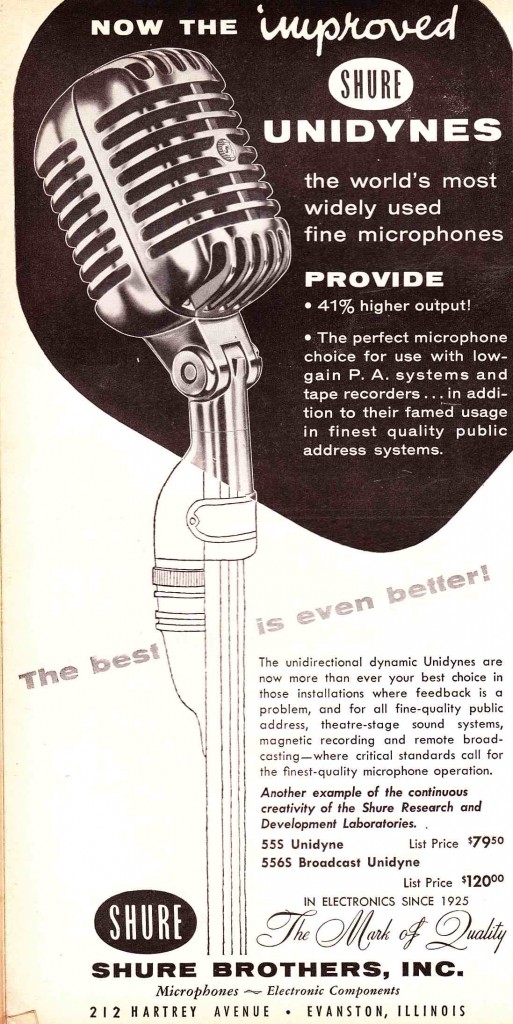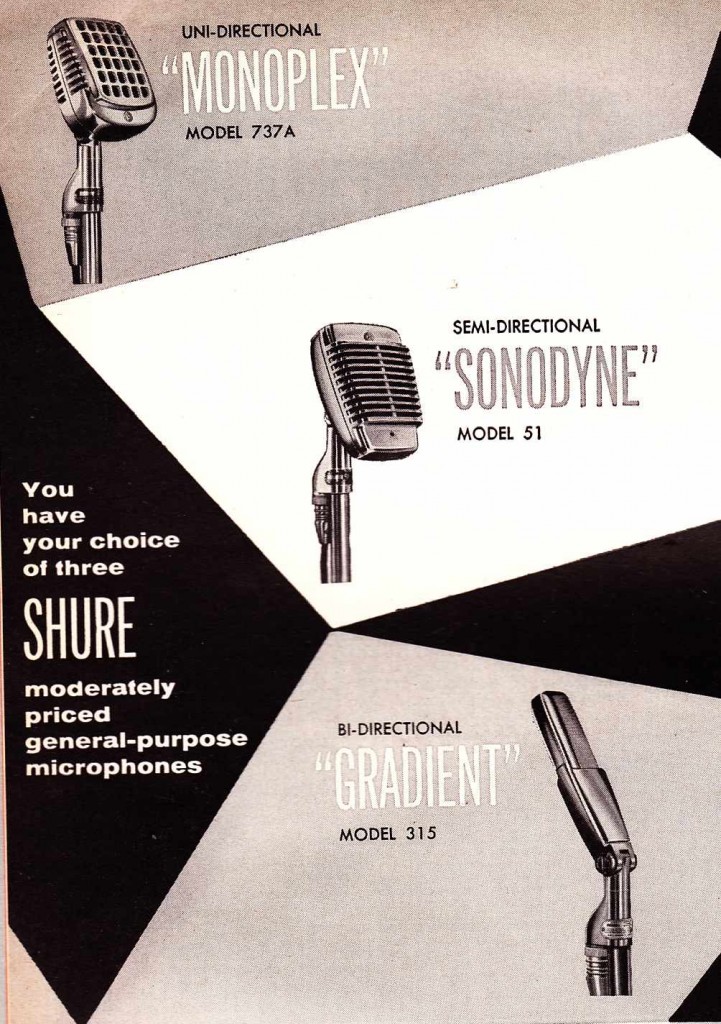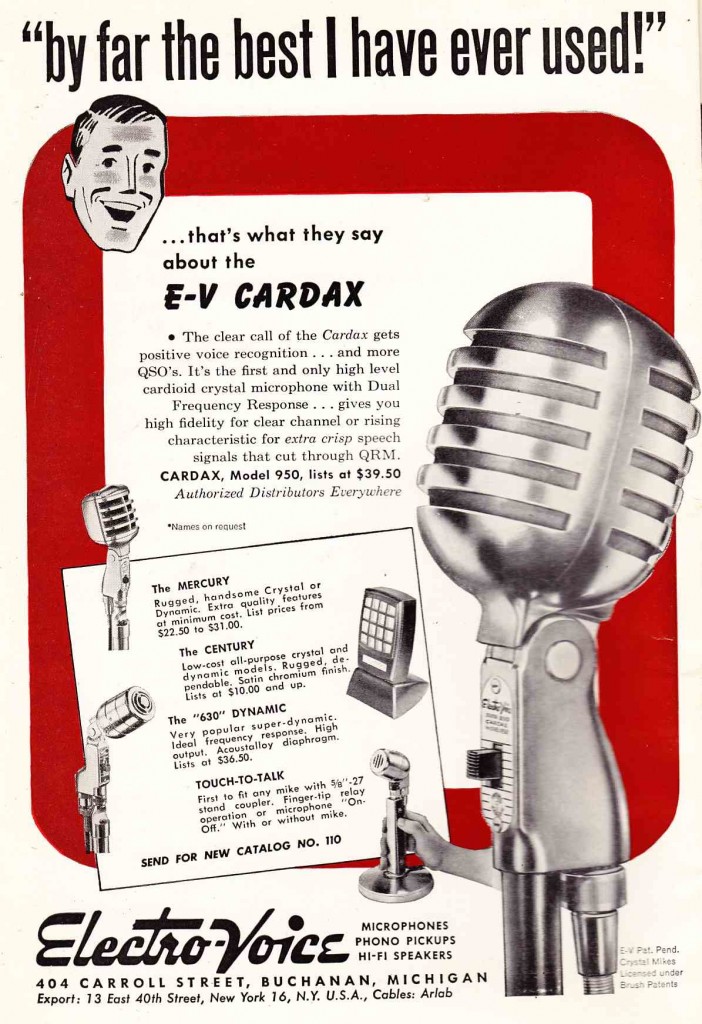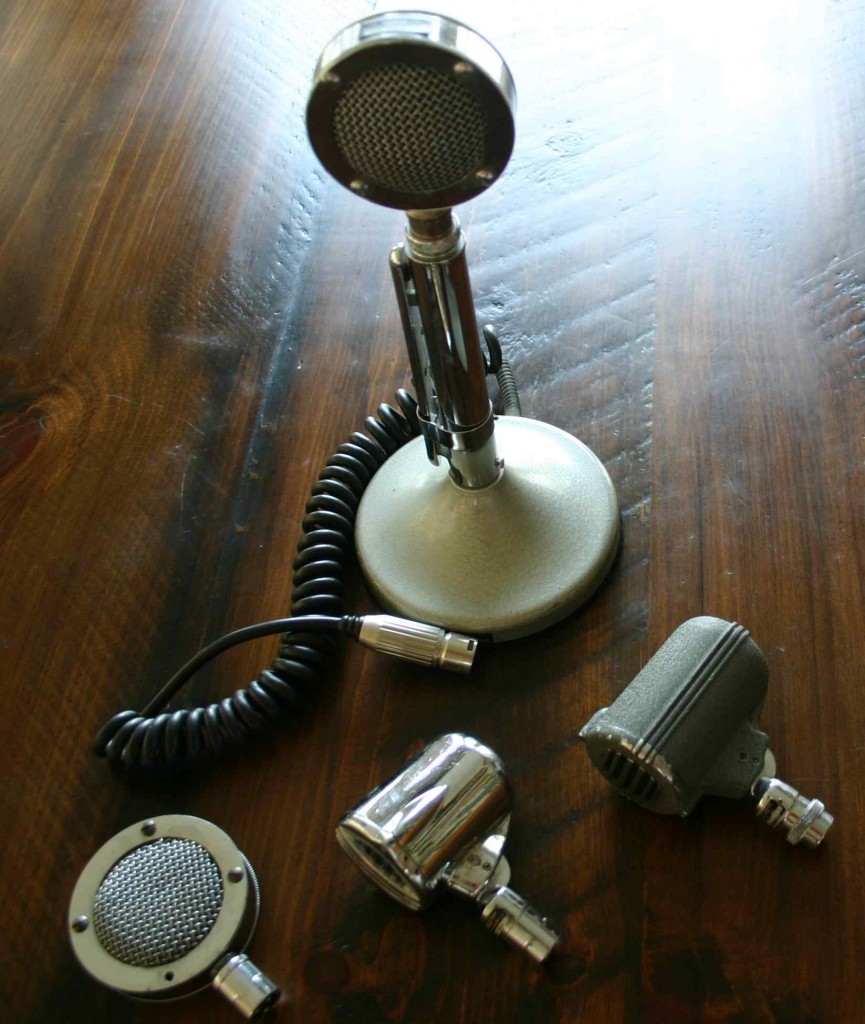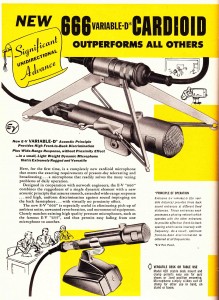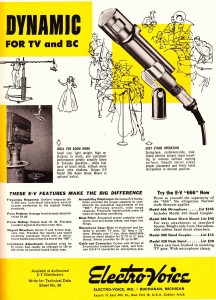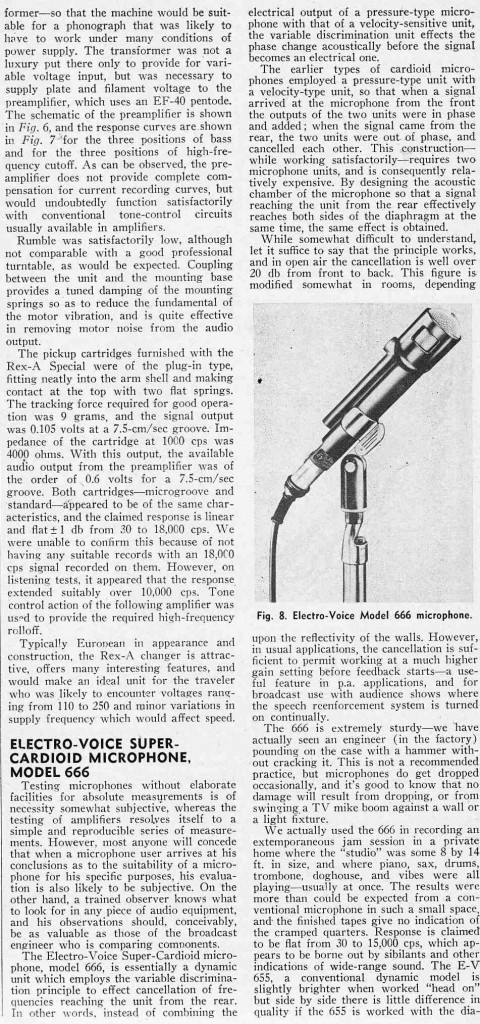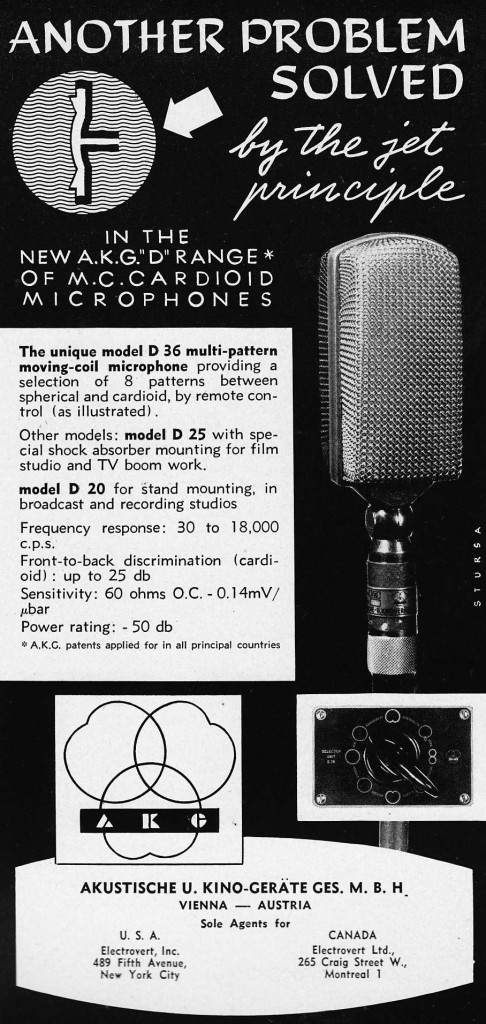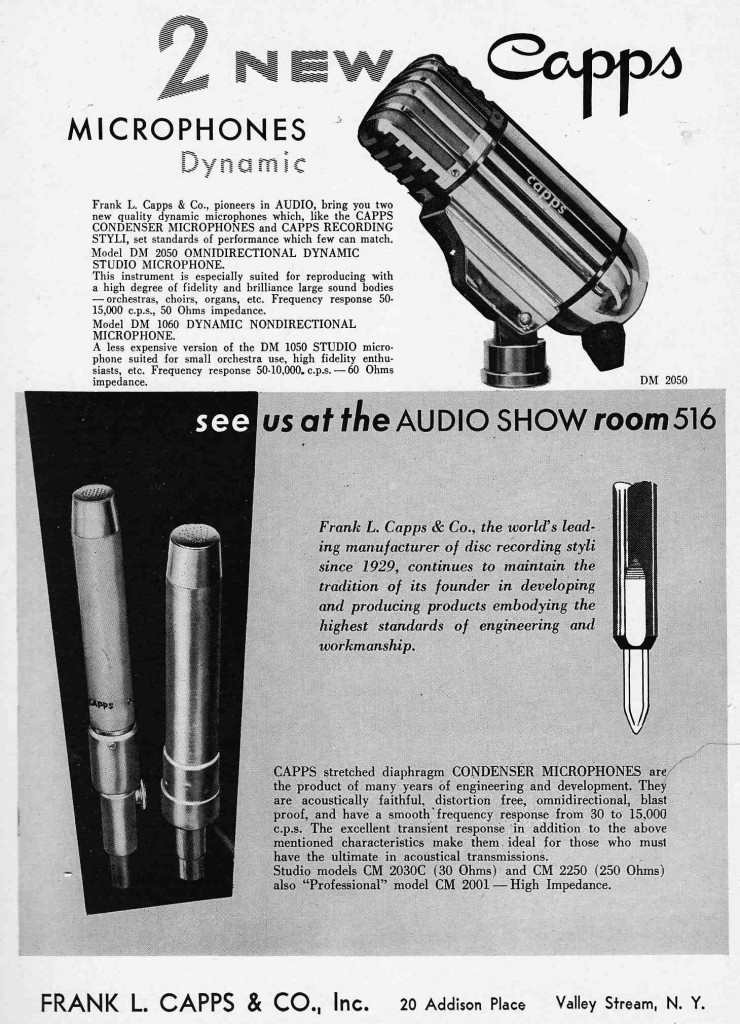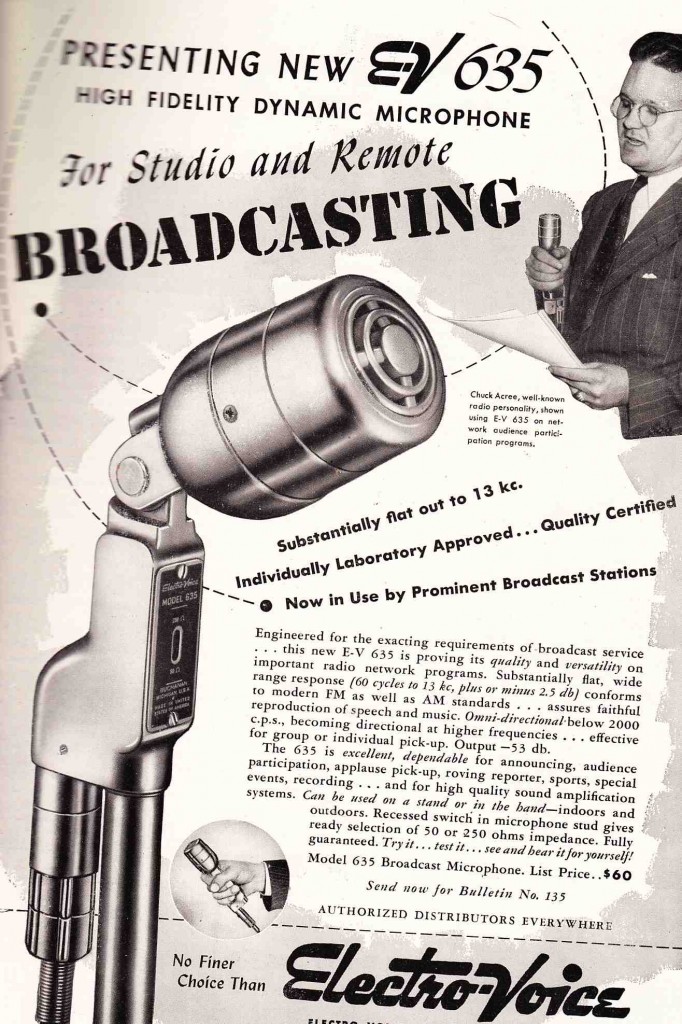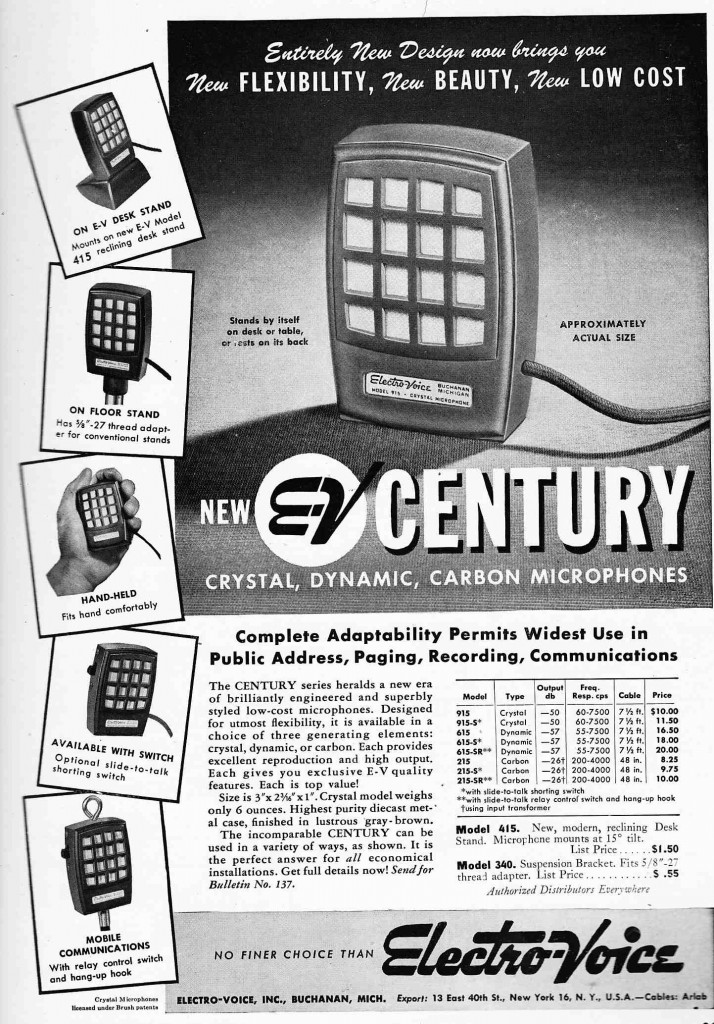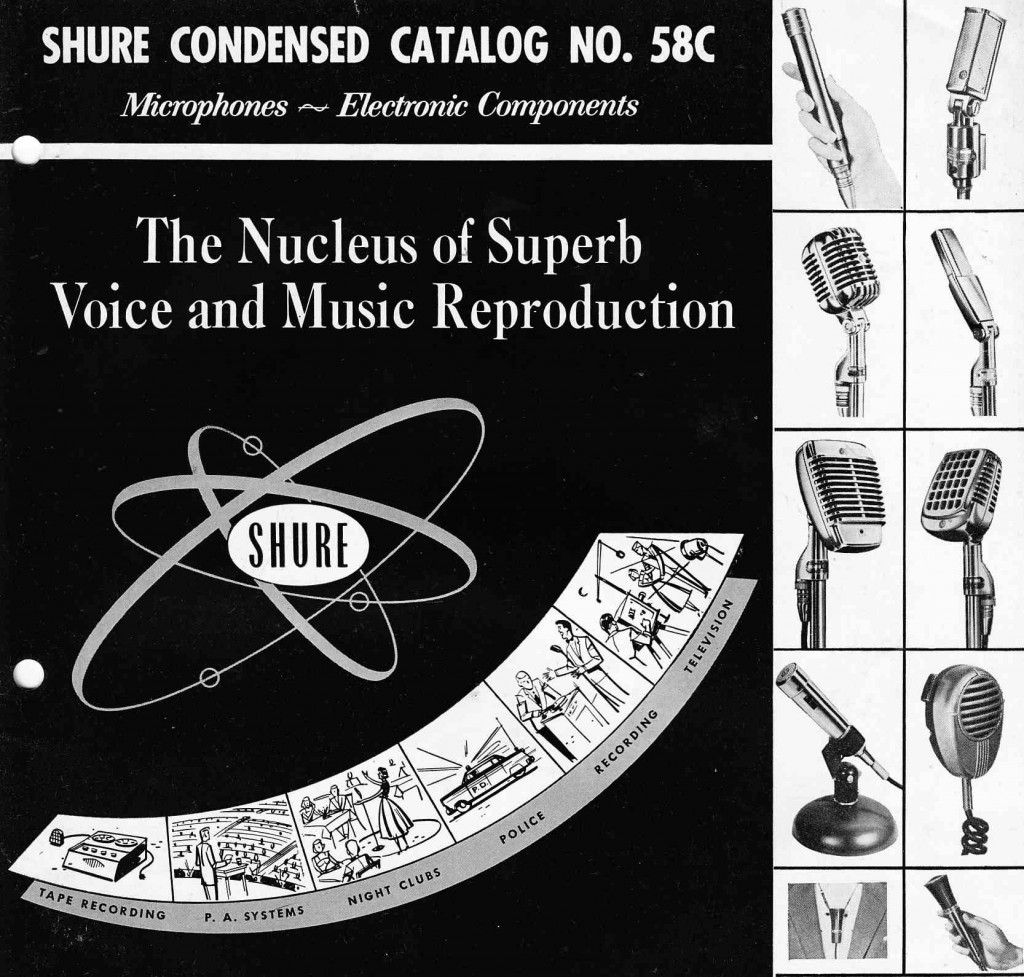Tag: shure
The Electrovoice Cardax Crystal Cardiod Microphone
Today we’ll look at some more microphones on offer to Radio Hams in the pages of QST Magazine circa 1947. The Electrovoice Cardax pictured above seems to have been a popular choice; this mic appears on photographs of numerous Ham radio shacks of the era. It is odd then that I have never come across one of these in all my years of digging. Are crystal mics less reliable than dynamics?
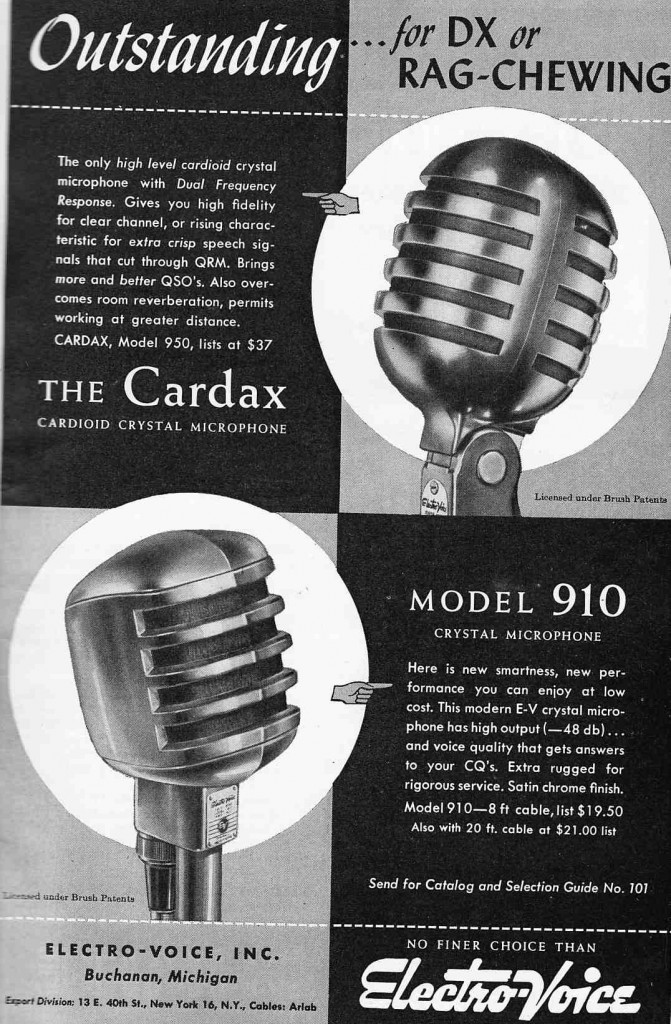 The Cardax again; also pictured is the 910, also a crystal, although presumably an omnidirectional. Half the price. Anyone using one of these?
The Cardax again; also pictured is the 910, also a crystal, although presumably an omnidirectional. Half the price. Anyone using one of these?
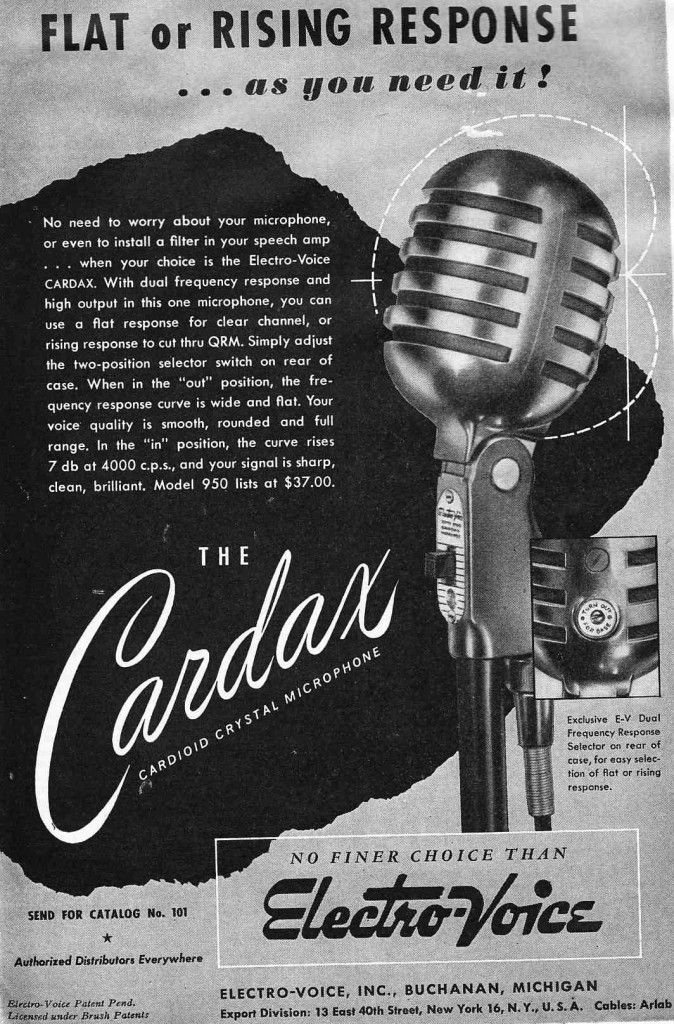 And the Cardax yet again. Here we learn that the Cardax has a presence-boost switch that adds a 7db peak at 4000 hz to add intelligibility to speech. Sennheiser notably offers this feature (well, similar enough) in their 441 cardioid dynamic. Good for use underneath a snare drum. (the 441, that is)
And the Cardax yet again. Here we learn that the Cardax has a presence-boost switch that adds a 7db peak at 4000 hz to add intelligibility to speech. Sennheiser notably offers this feature (well, similar enough) in their 441 cardioid dynamic. Good for use underneath a snare drum. (the 441, that is)
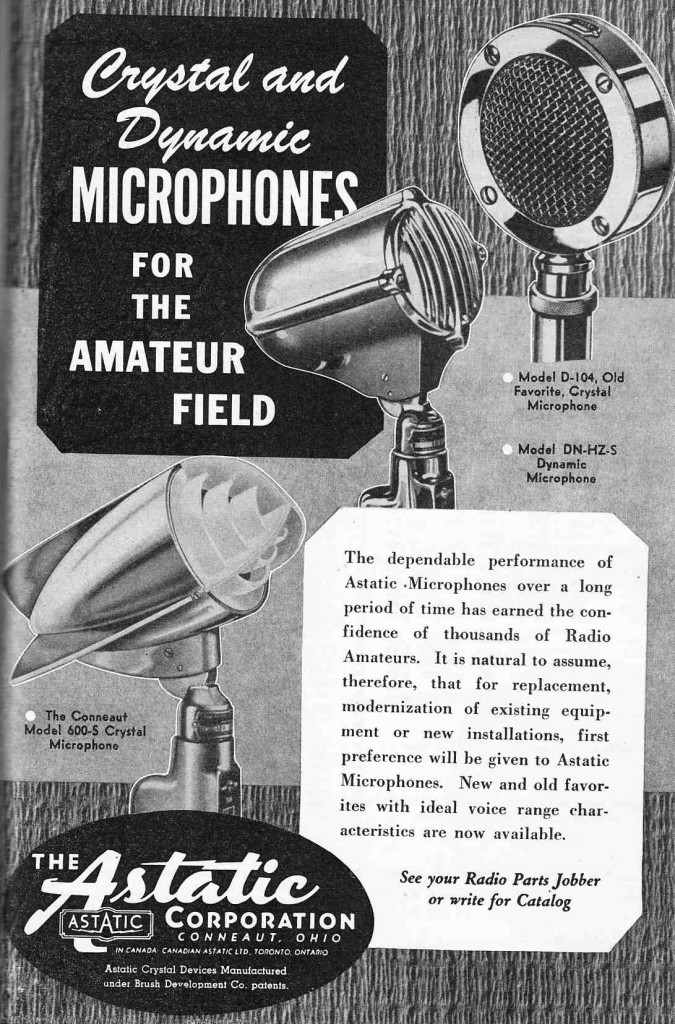
Astatic (seemingly) made microphones exclusively for the ‘communications’ (as opposed to recording or live-sound-reinforcement) market. The Astatic D-104 is the most iconic of Ham radio mics. The D-104 consists of a removable ‘head’ that attaches to a transistorized base with a push-to-talk bar. Above are a few of the ‘heads’ that mate with the D-104 base. Now that I think about it… what were these heads used with in the 1940s, prior to the introduction of the transistor?
Above is my D104 base with the working heads that I have accumulated. I’ve bought plenty of non-working ones as well. The ‘bullet’ shaped heads are dynamic and the round ones are crystal element.
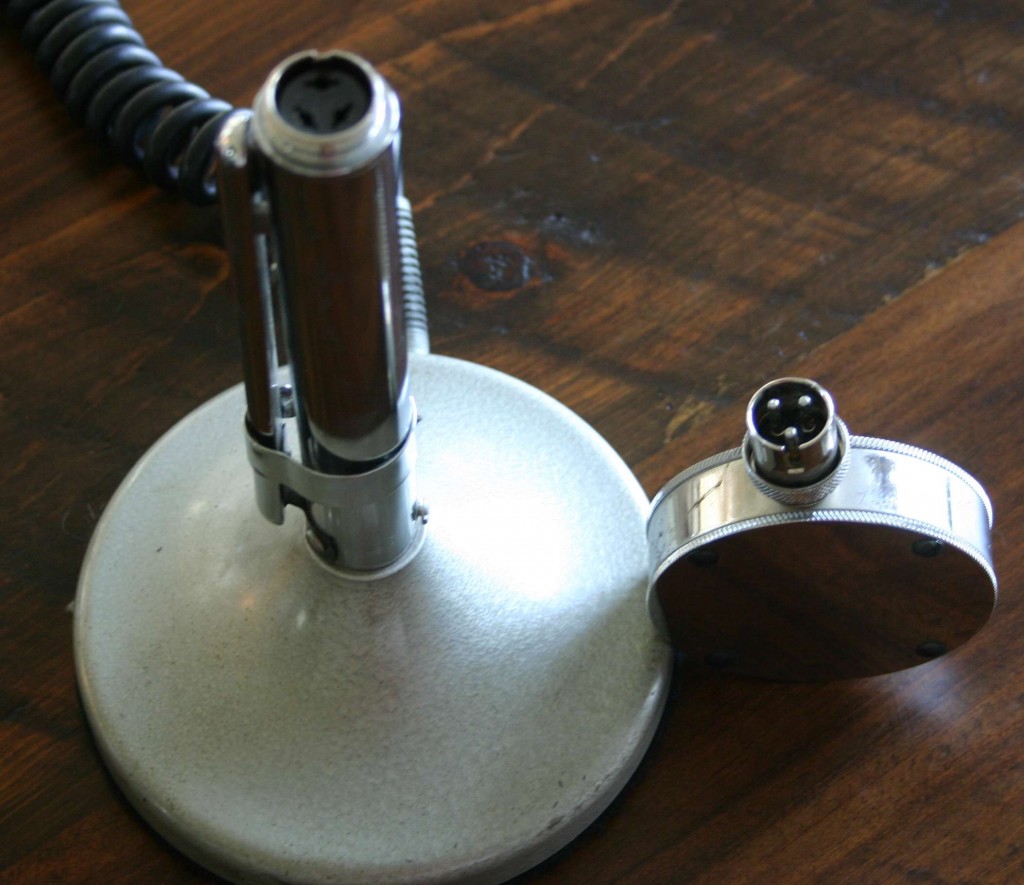 Here you can see the head removed from the base. As i said earlier, the base consists of a 9V battery-powered preamp and a large ‘push-to-talk’ bar. You will usually find these units with a 4 (or more) pin output connector designed to mate with some certain Ham radio transmitter. I modified this one to have a standard XLR-M output jack. It seems to work fine into any mic preamp. So… what can you do if you want to use these heads without the noisy, bulky base?
Here you can see the head removed from the base. As i said earlier, the base consists of a 9V battery-powered preamp and a large ‘push-to-talk’ bar. You will usually find these units with a 4 (or more) pin output connector designed to mate with some certain Ham radio transmitter. I modified this one to have a standard XLR-M output jack. It seems to work fine into any mic preamp. So… what can you do if you want to use these heads without the noisy, bulky base?
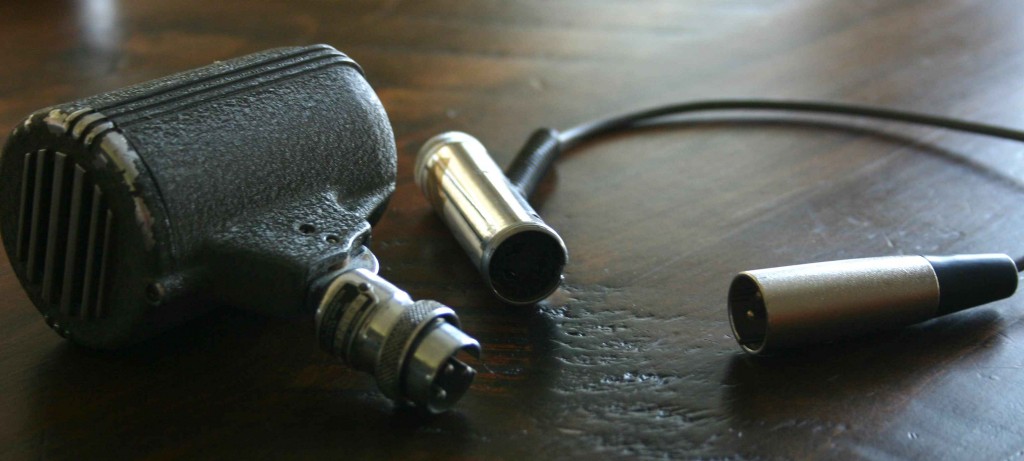 At some point I came across the 3-pin-Amphenol barrel-adaptor in the center above. Add a short length of wire and an XLR-M and voila. Seems to work fine into the mic preamps in my little Mackie test-mixer. Which I imagine has fairly high input impedance, likely 1500 ohms or more. Honestly not sure if the performance would be the same into a 150ohm or 600 ohm mic input but… point is, if you find some of these heads, yes they can be used easily without the base unit.
At some point I came across the 3-pin-Amphenol barrel-adaptor in the center above. Add a short length of wire and an XLR-M and voila. Seems to work fine into the mic preamps in my little Mackie test-mixer. Which I imagine has fairly high input impedance, likely 1500 ohms or more. Honestly not sure if the performance would be the same into a 150ohm or 600 ohm mic input but… point is, if you find some of these heads, yes they can be used easily without the base unit.
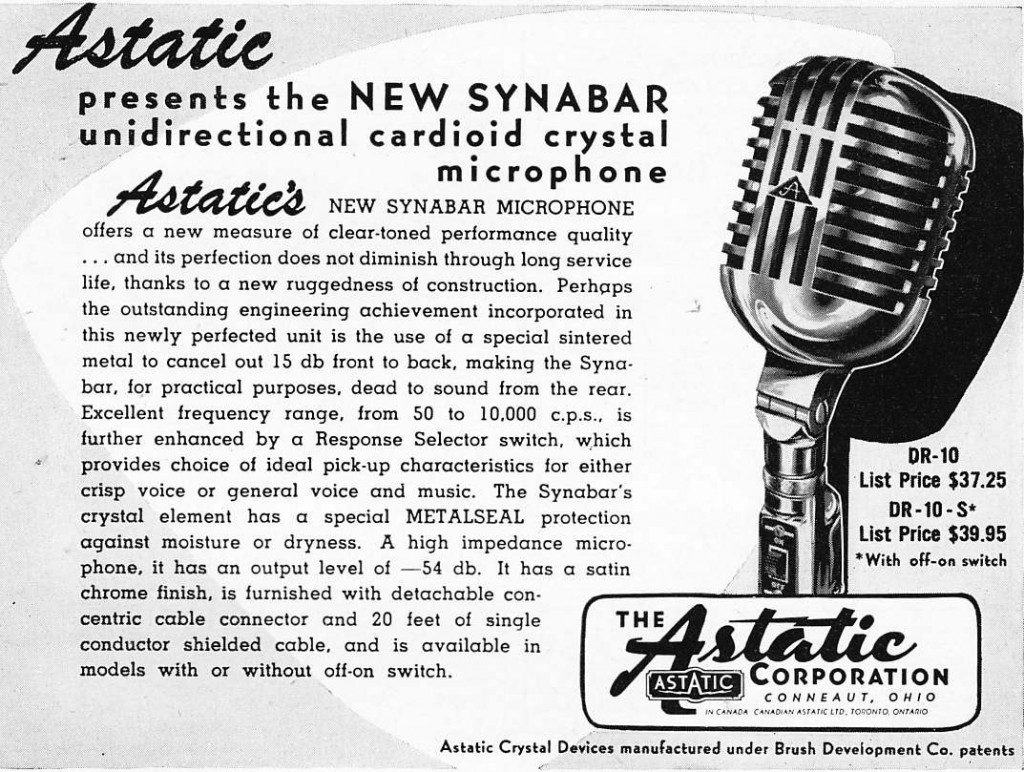 Alright back into it. Above is the Astatic Synabar. Never seen one of these. Seems to be identical to the EV cardax: same feature set, pricing, etc.
Alright back into it. Above is the Astatic Synabar. Never seen one of these. Seems to be identical to the EV cardax: same feature set, pricing, etc.
********
Above: an advert for the Shure ‘Versatex,’ a plastic-bodied crystal mic. Great design. And very rare AFAICT. To the right we have the venerable Shure “556” broadcast-dynamic mic, one of the better -quality microphones made in the 1940s. The best modern comparison would probably be the SM-7. Anyhow, the fire-damaged 556 is depicted here not to sell 556s, but as “a living testimonial to the ruggedness and dependability of all Shure Microphones.” Presumably this does not include plastic microphones such as the Versatex, which could not fare well in a firey inferno. The advert goes on add: “For Ham use, we recommend the 708A Stratoliner and the 707A Cyrstal Microhones.”
********
And there you have it. The 707 may look like the famous Shure ‘Green Bullet,’ but the element, and the sound, is completely different. The Green bullet uses a dynamic element with a property that Shure calls ‘Controlled Reluctance,’ which basically indicates a dynamic mic element that does not require an output transformer to mate with the input transformer of a mic preamp. The 707, on the other hand, is a crystal mic.
Studio Microphones of 1955
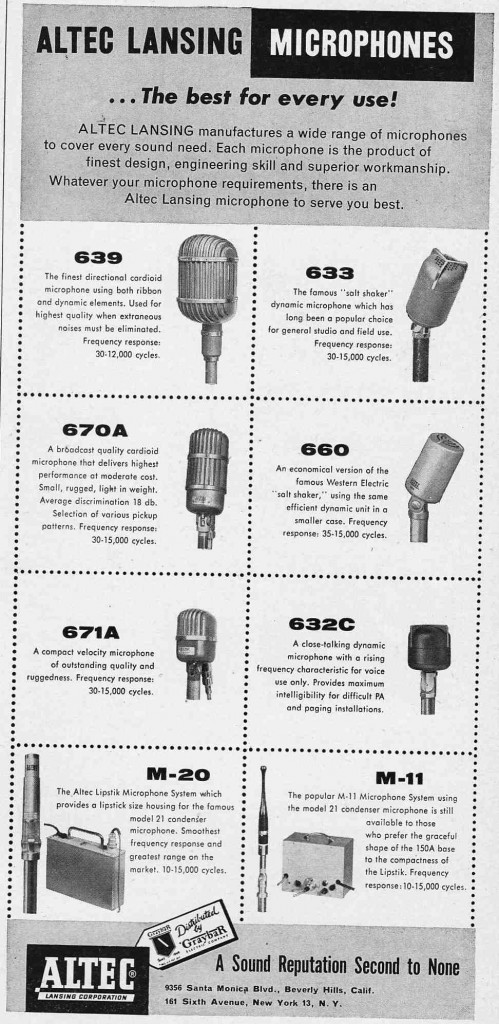 The Altec 639, 633, 670A, 660, 671A, 632C, M-20, and M-11 microphones
The Altec 639, 633, 670A, 660, 671A, 632C, M-20, and M-11 microphones
From the pages of AUDIO magazine in 1954/55: new and new-ish studio microphones at the dawn of the transistor age. Check em out…
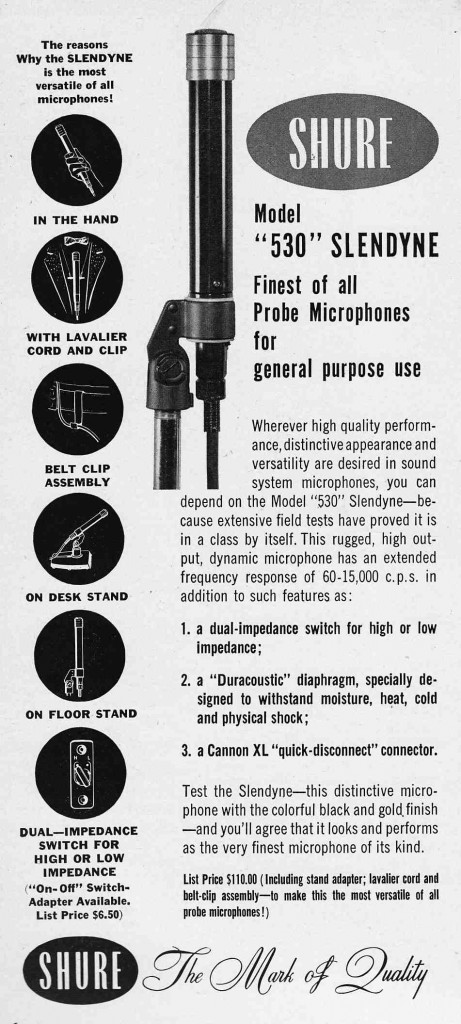 The Shure 530. This was Shure’s mid-range ‘pencil’ mic in the 1950s. At the top end was the 525; lower in the line was the 535. See this link for some audio tests including the 535.
The Shure 530. This was Shure’s mid-range ‘pencil’ mic in the 1950s. At the top end was the 525; lower in the line was the 535. See this link for some audio tests including the 535.
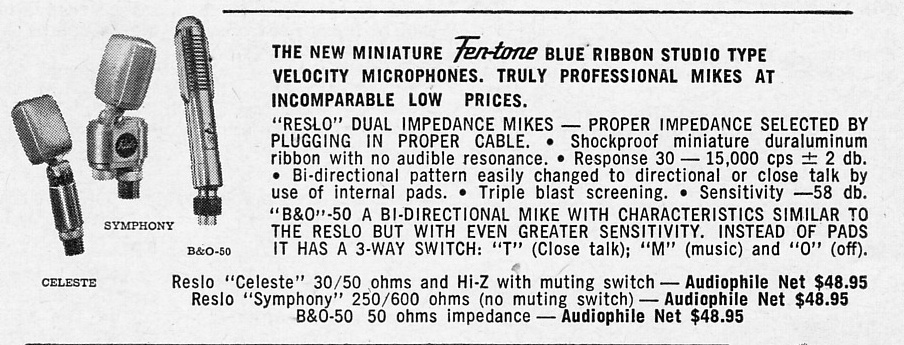 Reslo and Bang & Olufsen ribbon microphones were marketed and distributed in the USA under the ‘Fentone’ banner in the 1950s. Fentone continued as a brand-name for microphone marketing into the 1960s, but later Fentone product was not of this quality.
Reslo and Bang & Olufsen ribbon microphones were marketed and distributed in the USA under the ‘Fentone’ banner in the 1950s. Fentone continued as a brand-name for microphone marketing into the 1960s, but later Fentone product was not of this quality.
Above is the two-page advertising spread that introduced the Electrovoice 666 to the world. The 666 is the grandfather of the much-beloved Electrovoice Re20, which has been a favorite of recording and live-sound engineers for decades. Like the Sennhesier 421, the RE-20 is somewhat proof that dynamic microphone technology hasn’t really advanced much in the past three decades.
********************
Above, a 1955 advert for the 666 along with a review of the 666 from AUDIO magazine.
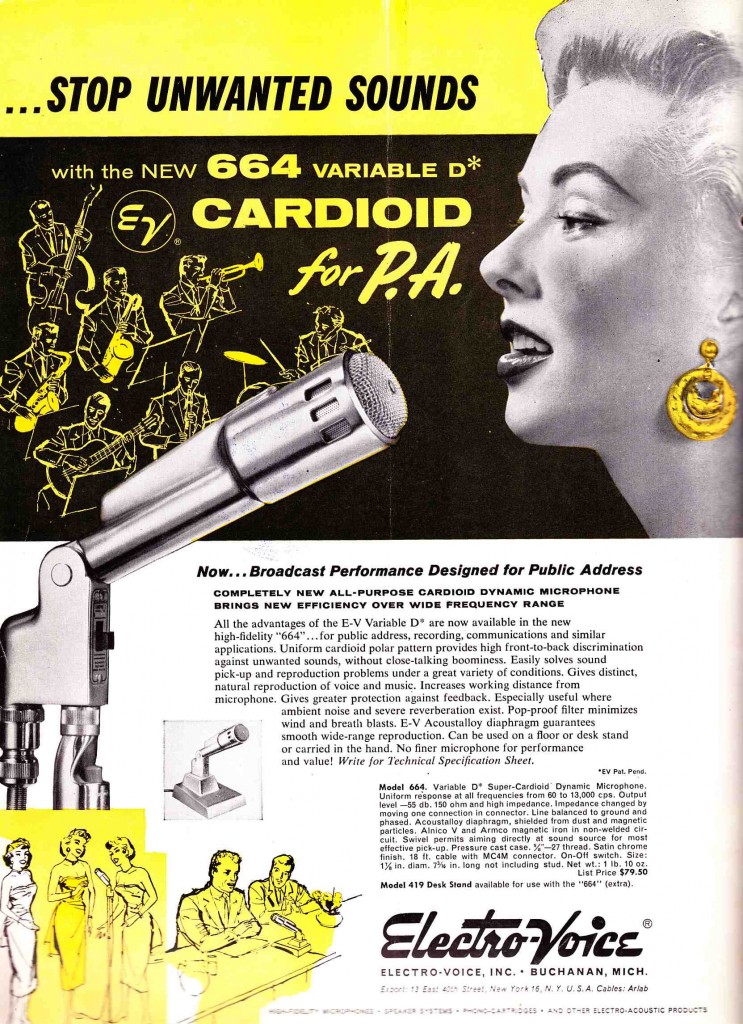 Above is a 1955 ad for the Electrovoice 664. The 664 was the ‘public address’ aka ‘cheaper’ version of the 666; the 664 was immensely popular and thousands remain today. If you come across one of these, there is a good chance it will still work fine. In terms of visual recognition, I would argue the 664 has an iconic appeal exceeded only by the Shure 55 series and the RCA 77 and 44 series. The 664 is not a terrible sounding microphone, although i don’t recommend actually using it in a modern high-decibel PA system.
Above is a 1955 ad for the Electrovoice 664. The 664 was the ‘public address’ aka ‘cheaper’ version of the 666; the 664 was immensely popular and thousands remain today. If you come across one of these, there is a good chance it will still work fine. In terms of visual recognition, I would argue the 664 has an iconic appeal exceeded only by the Shure 55 series and the RCA 77 and 44 series. The 664 is not a terrible sounding microphone, although i don’t recommend actually using it in a modern high-decibel PA system.
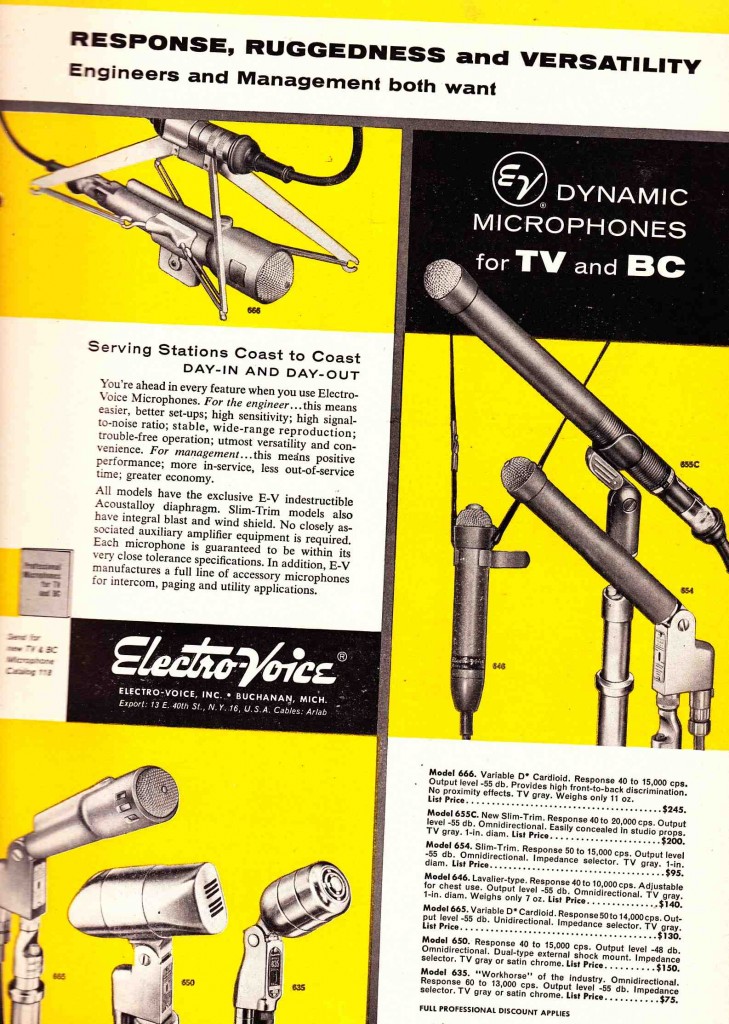 Wrapping up, here’s an ad for all the microphones that Electrovoice considered its ‘professional quality’ in 1955: the 666, lesser-variant 665, 655, its lesser variant 654, 646 lavalier, 650 and 535. Hear my pair of ancient 655s in-action here…
Wrapping up, here’s an ad for all the microphones that Electrovoice considered its ‘professional quality’ in 1955: the 666, lesser-variant 665, 655, its lesser variant 654, 646 lavalier, 650 and 535. Hear my pair of ancient 655s in-action here…
Continuing our survey of AUDIO magazine’s early years: over the next couple of weeks we will look at some of the more relevant content from the first two years that this venerable publication ran under the title ‘Audio,’ the prior title having been ‘Audio Engineering.’ (full backstory here and here). We’ll start today with the crop of studio microphones on the market in 1954. One thing becomes pretty clear: the Austrians were really ahead of their time.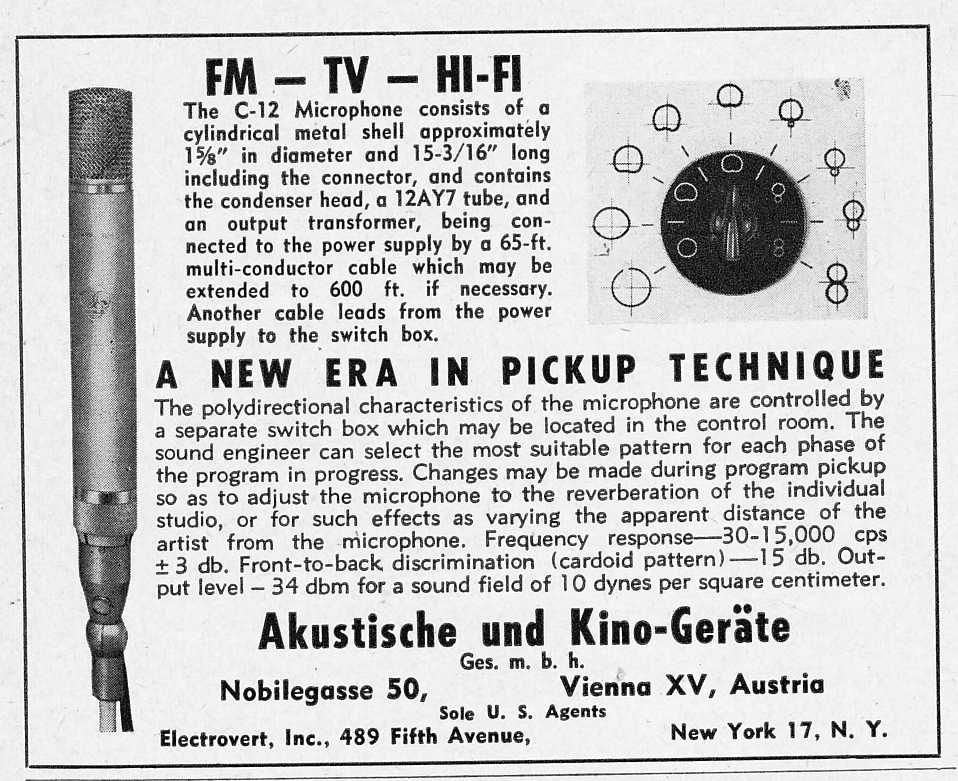 AKG C-12 advert 1954
AKG C-12 advert 1954
Telefunken U-47 and 201-M adverts 1954
Capps CM 2001, 2030, 2250, and DM 2050 microphones c. 1954.
Anyone have any experience with these mics? Look interesting. Let us know…
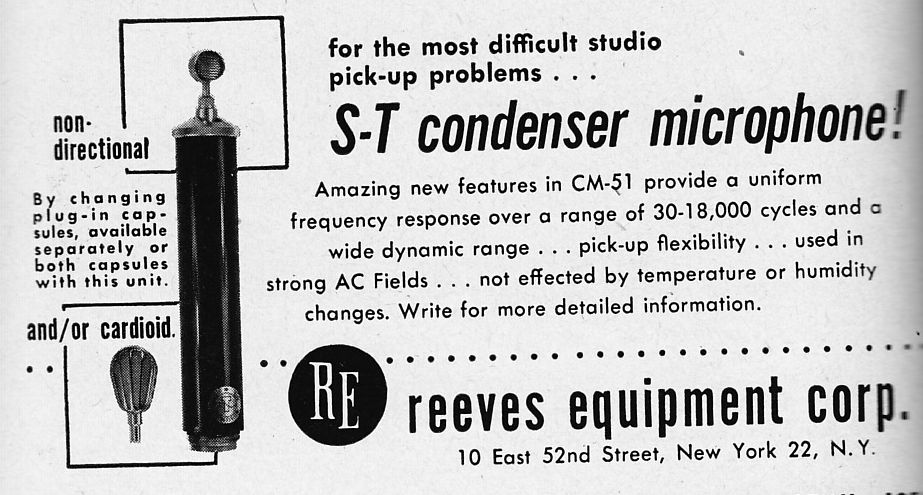 The Reeves S-T Condenser Microphone; another early American Condenser mic. Very rare.
The Reeves S-T Condenser Microphone; another early American Condenser mic. Very rare.
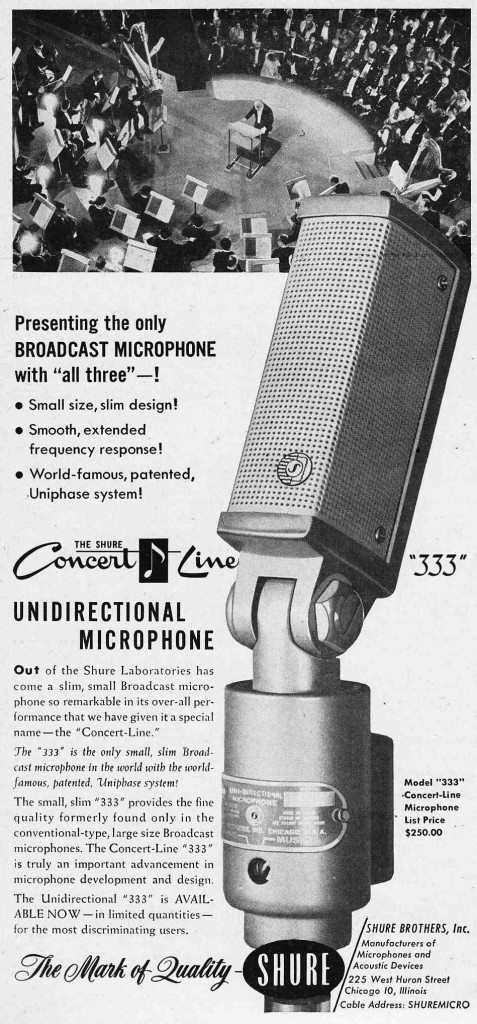 The Shure 333 ribbon mic. This was their cardiod ribbon. I’ve never used one of these, but i would love to get my hands on one. Stephen Sank recently re-ribboned my circa 1954 Shure 300 (the 300 was Shure’s high-end figure-8 ribbon of the same period) and wow did he do a great job. It sounds incredible now. I had thought it was a P.O.S. until he re-did it. If you own a vintage Shure ribbon mic and you are underwhelmed by it. give Sank a call and see what he can do for you.
The Shure 333 ribbon mic. This was their cardiod ribbon. I’ve never used one of these, but i would love to get my hands on one. Stephen Sank recently re-ribboned my circa 1954 Shure 300 (the 300 was Shure’s high-end figure-8 ribbon of the same period) and wow did he do a great job. It sounds incredible now. I had thought it was a P.O.S. until he re-did it. If you own a vintage Shure ribbon mic and you are underwhelmed by it. give Sank a call and see what he can do for you.
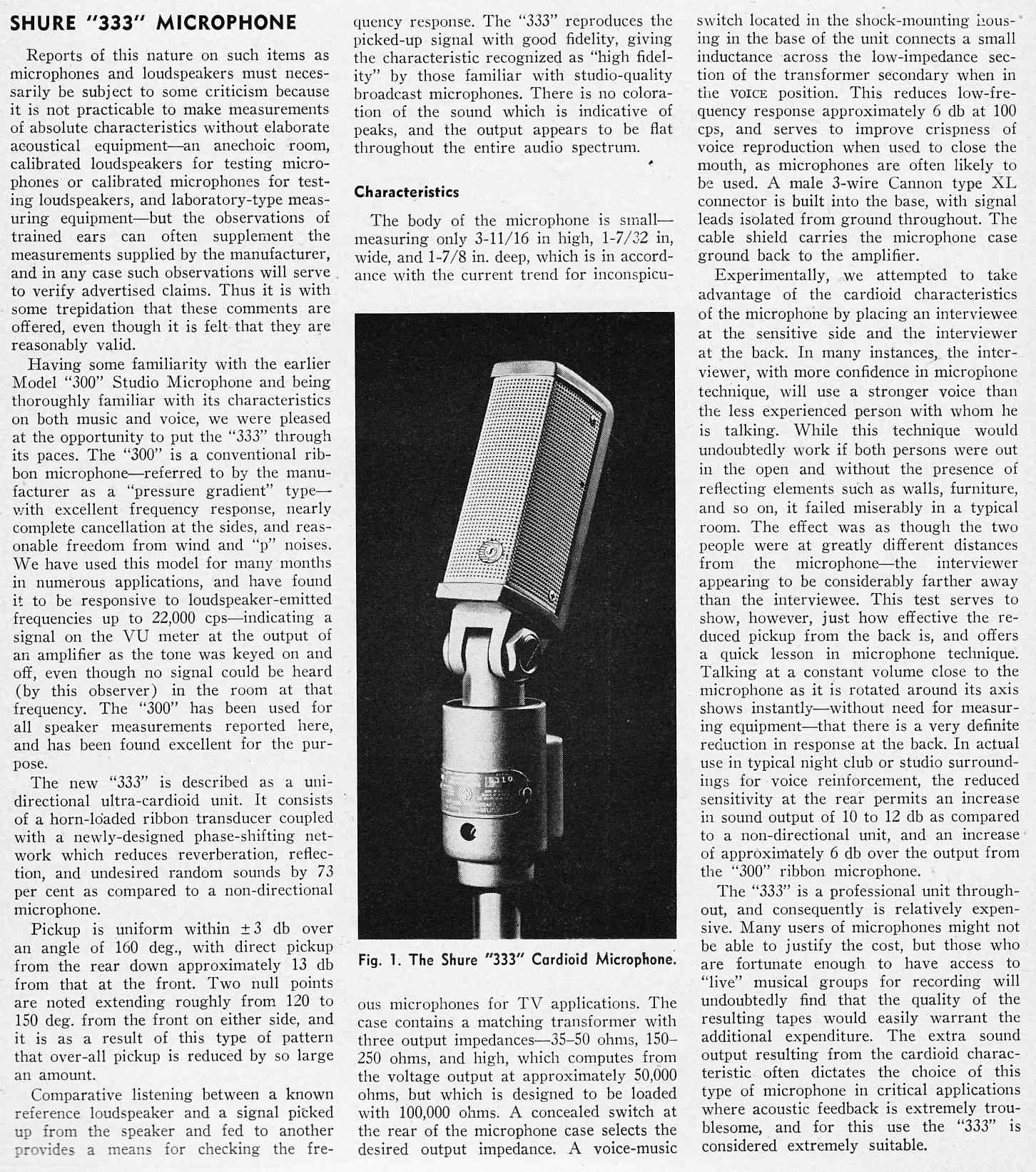 …and here is some period analysis of the then-new Shure 333.
…and here is some period analysis of the then-new Shure 333.
Follow the link below to READ-ON…. more studio mics of ’54 follow….
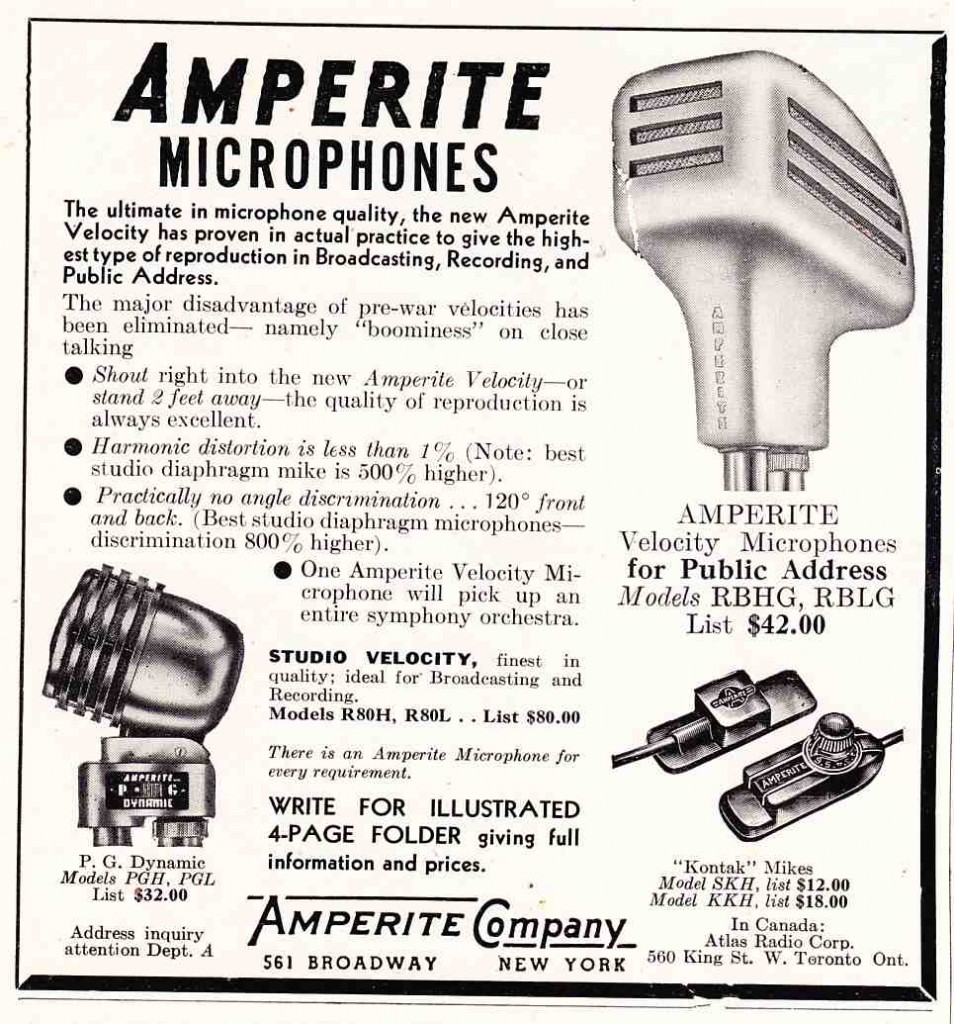 The Amperite Velocity Microphone
The Amperite Velocity Microphone
Continuing our review of Audio Engineering Magazine, today we will look at some of new offerings in microphones available to audio engineers in the late 1940s.
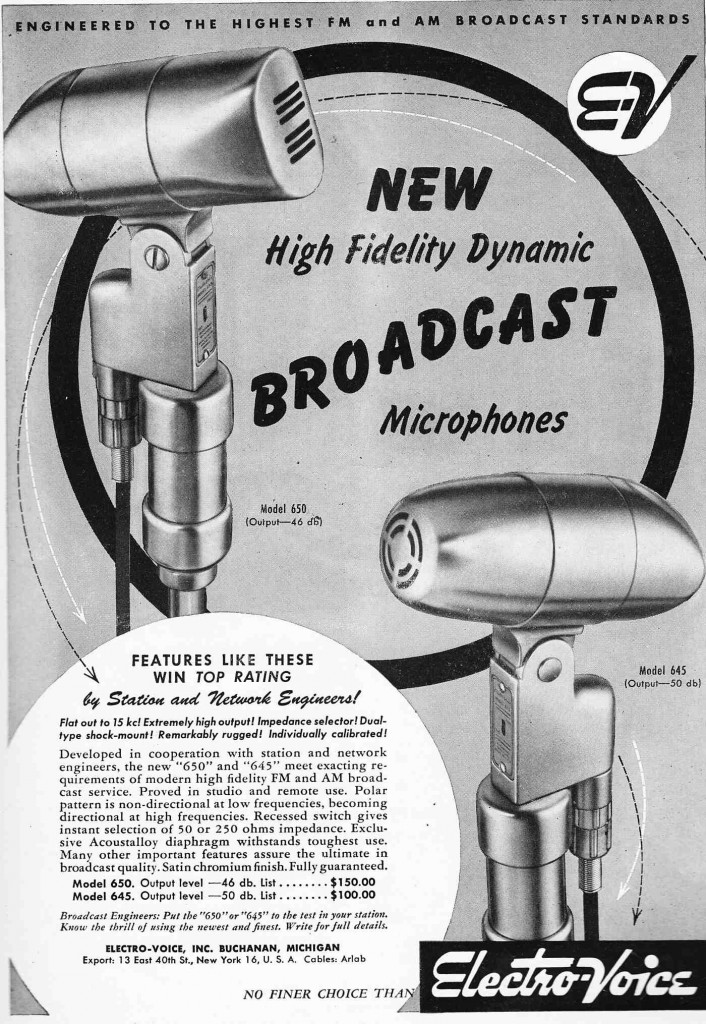 The Electrovoice 650 and 645. I really would like a nice 650… the ‘Jac Holzman Mic’
The Electrovoice 650 and 645. I really would like a nice 650… the ‘Jac Holzman Mic’
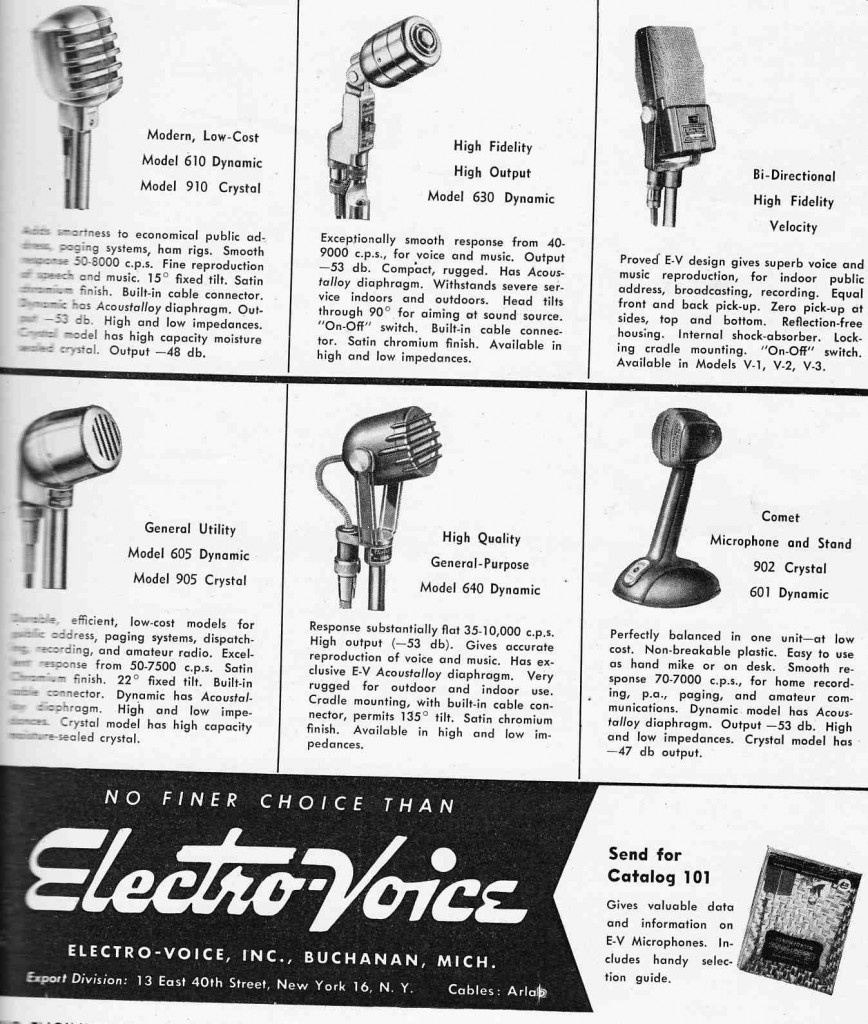 An Electrovoice line-up circa ’47
An Electrovoice line-up circa ’47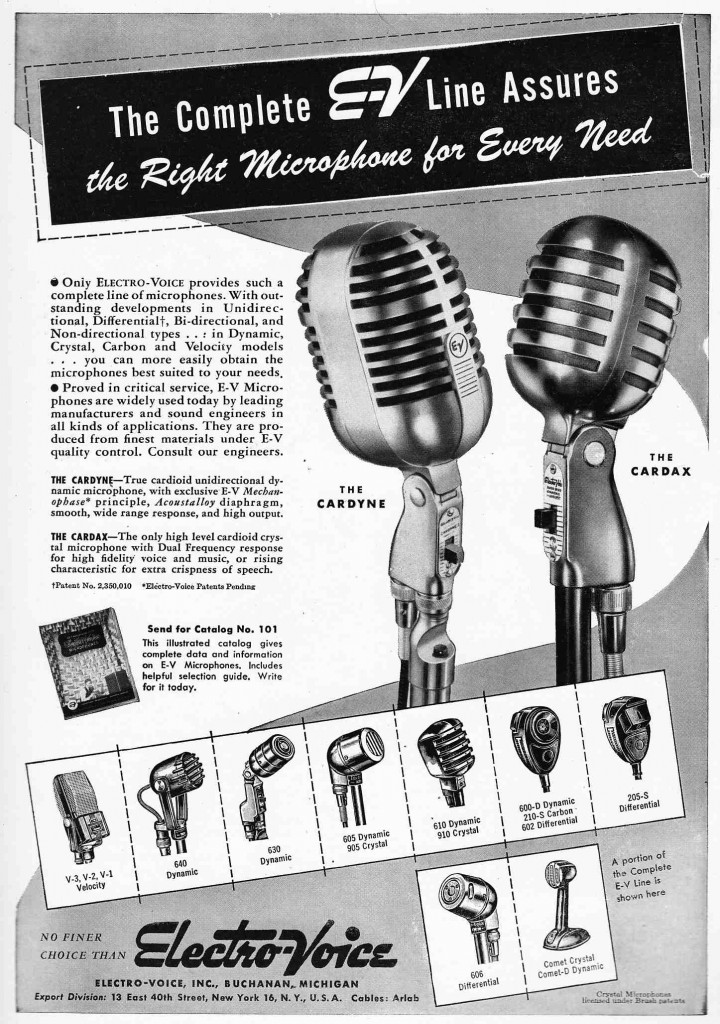 The Electrovoice Cardyne and Cardax
The Electrovoice Cardyne and Cardax
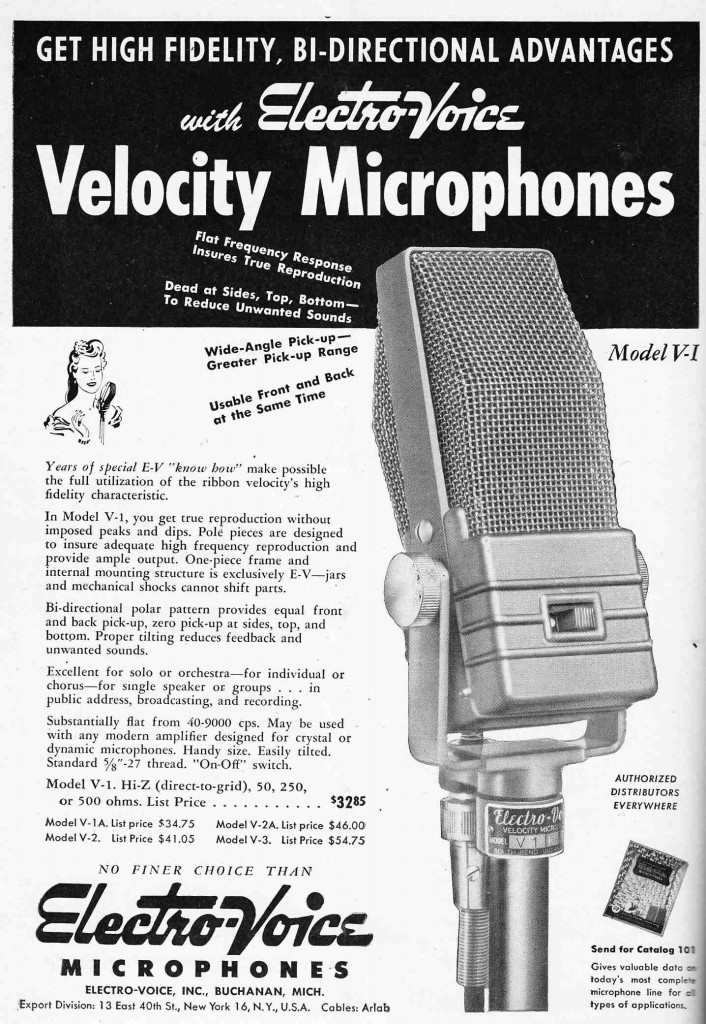 The Electrovoice V1 ribbon mic.
The Electrovoice V1 ribbon mic.
Many more images follow. Click the link below to Read-On…
Oddball dynamic mics of olden days
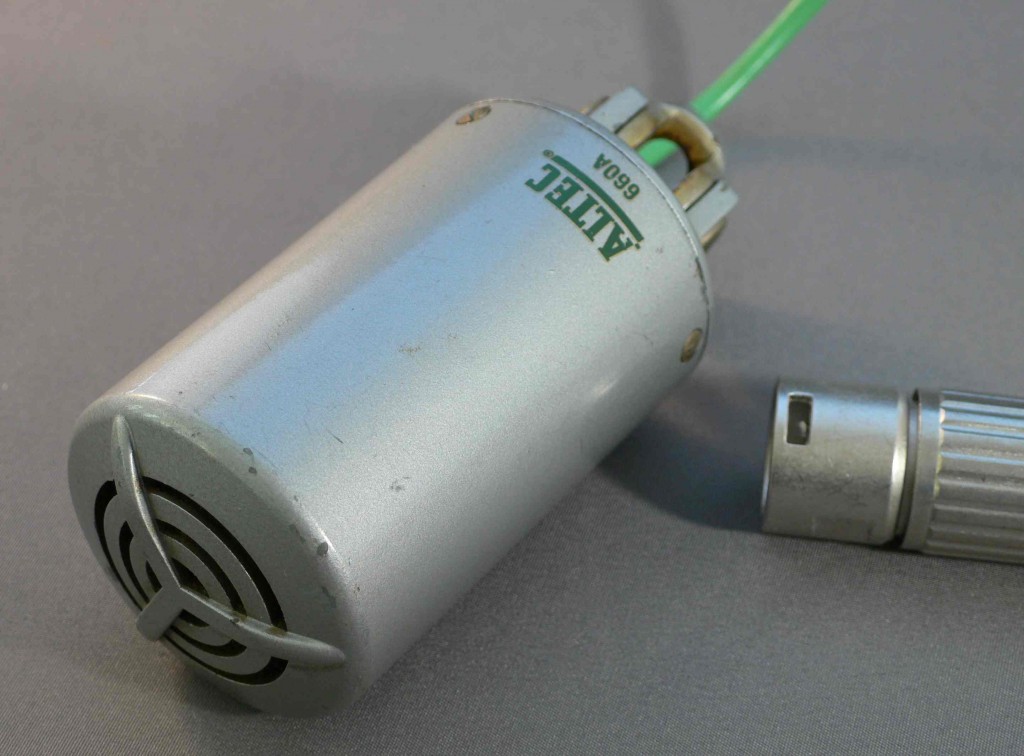 A quick review of some odd mics from the ‘pile’ that have not made it over to the studio yet. If anyone out there is using these for makin’ records, drop a line a let us know yr thoughts. Above is the Altec 660A, which is an Altec-branded iteration of an earlier western-electric mic. This thing sounds very thin. it’s quite small – check the XLR connector for size reference.
A quick review of some odd mics from the ‘pile’ that have not made it over to the studio yet. If anyone out there is using these for makin’ records, drop a line a let us know yr thoughts. Above is the Altec 660A, which is an Altec-branded iteration of an earlier western-electric mic. This thing sounds very thin. it’s quite small – check the XLR connector for size reference.
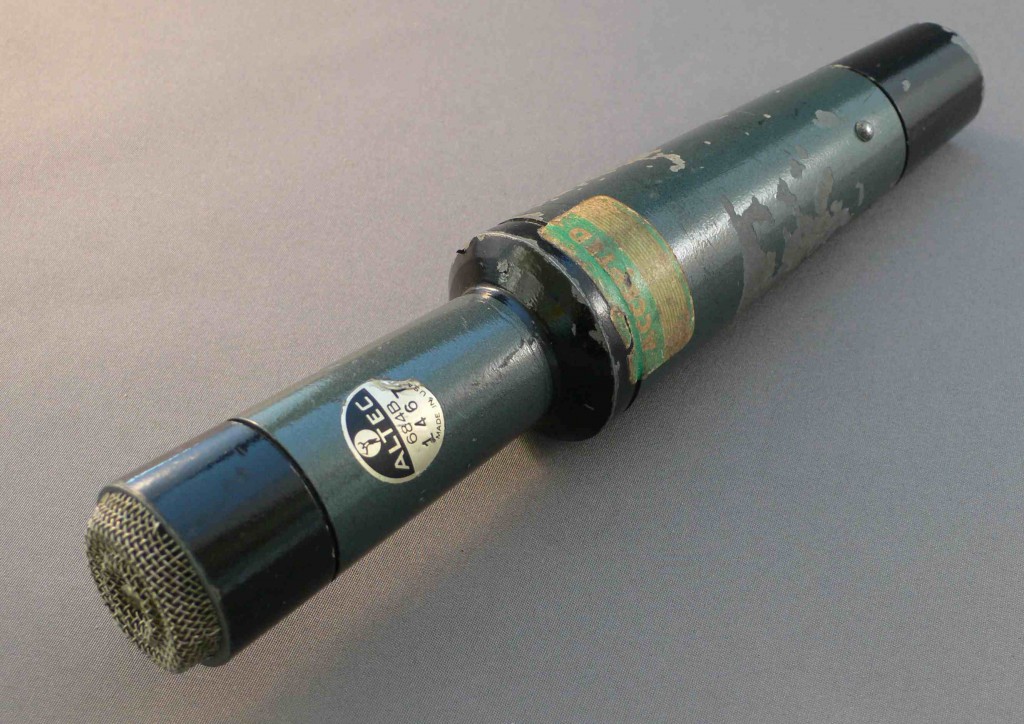 Another ancient Altec mic. this is a 684B. This piece does not sound bad, but… it failed the SM57 test. What, you ask, is the SM57 test? Well… whenever a new mic appears, i quickly A/B it with an SM57. If the SM57 sounds both ‘better’ (IE more ‘hi-fi’) AND ‘more interesting’ (this is harder to quantify….), then the new mic goes in a box somewhere. 684B up there failed the SM57 test.
Another ancient Altec mic. this is a 684B. This piece does not sound bad, but… it failed the SM57 test. What, you ask, is the SM57 test? Well… whenever a new mic appears, i quickly A/B it with an SM57. If the SM57 sounds both ‘better’ (IE more ‘hi-fi’) AND ‘more interesting’ (this is harder to quantify….), then the new mic goes in a box somewhere. 684B up there failed the SM57 test.
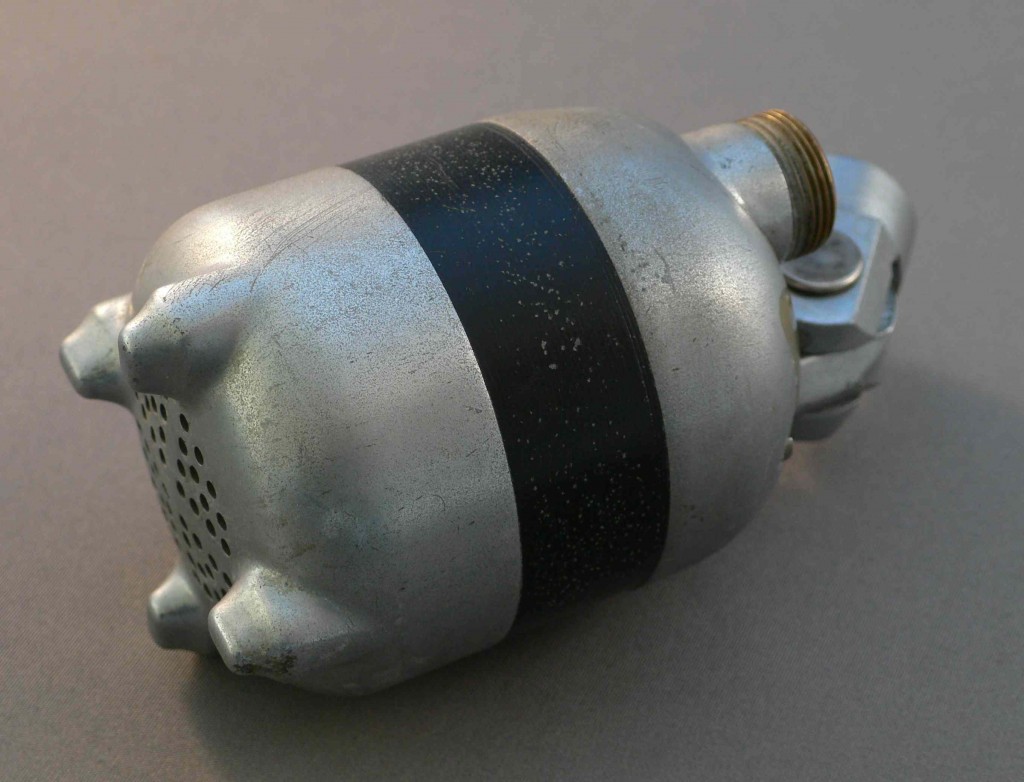 This is an American D4T. This is a hi-Z dynamic public-address mic from the 40s. This is, btw, the first antique mic i ever bought. picked this up at an antique shop in Prov RI back in the mid 90s, along with a little tube suitcase PA system and nice old cast-base mic stand… $75 i think…. This mic still works, and it sounds cool, but it’s just too distorted… feel like it sounds too ‘Pop,’ of all things, at this moment; ‘distressed-vocals’ being the trendy thing that they are.
This is an American D4T. This is a hi-Z dynamic public-address mic from the 40s. This is, btw, the first antique mic i ever bought. picked this up at an antique shop in Prov RI back in the mid 90s, along with a little tube suitcase PA system and nice old cast-base mic stand… $75 i think…. This mic still works, and it sounds cool, but it’s just too distorted… feel like it sounds too ‘Pop,’ of all things, at this moment; ‘distressed-vocals’ being the trendy thing that they are.
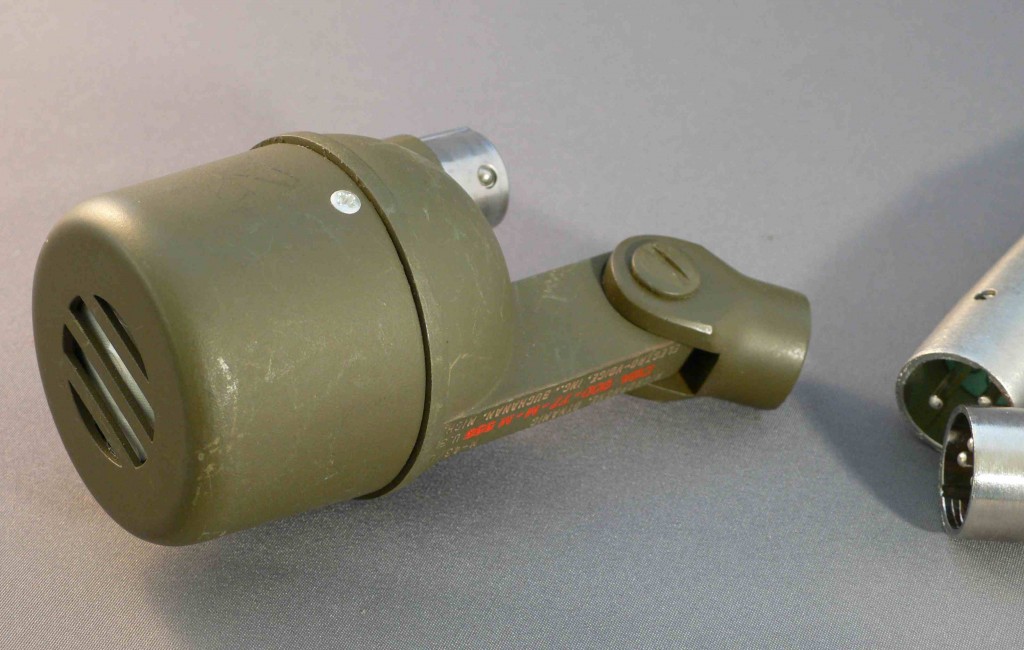 An Electro-voice military communications mic. Got this one still in its heremetically-sealed, foil-lined pouch. It ain’t bad, but… i have too many mics like this, only just slightly better….
An Electro-voice military communications mic. Got this one still in its heremetically-sealed, foil-lined pouch. It ain’t bad, but… i have too many mics like this, only just slightly better….
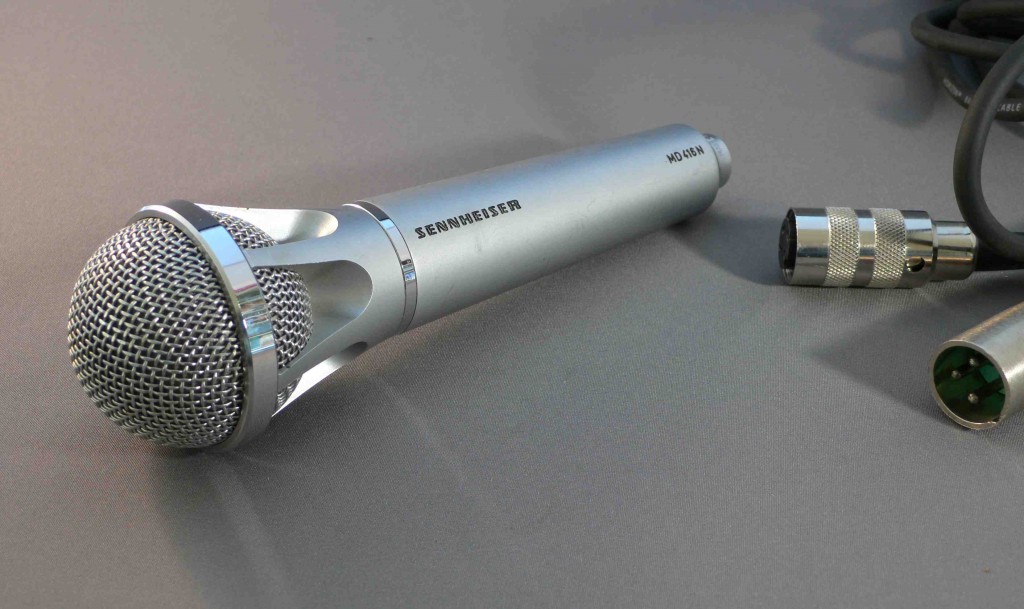 A Sennheiser MD 416. I was really excited about this thing, and i paid like $100 for it, which is a fortune for a cheapskate like me. Now, I have a lot of old sennhesiers… an original 409, 421, and several 441s… and i really dig them… but this thing just has no… balls? No low-end, at least. And that Mini-Tuchel-to-XLR cable wasn’t cheap either. This gets my vote for the most-expensive-mic-that-looks-like-a-really-cheap-mic. I will call it Paris H. from now on.
A Sennheiser MD 416. I was really excited about this thing, and i paid like $100 for it, which is a fortune for a cheapskate like me. Now, I have a lot of old sennhesiers… an original 409, 421, and several 441s… and i really dig them… but this thing just has no… balls? No low-end, at least. And that Mini-Tuchel-to-XLR cable wasn’t cheap either. This gets my vote for the most-expensive-mic-that-looks-like-a-really-cheap-mic. I will call it Paris H. from now on.
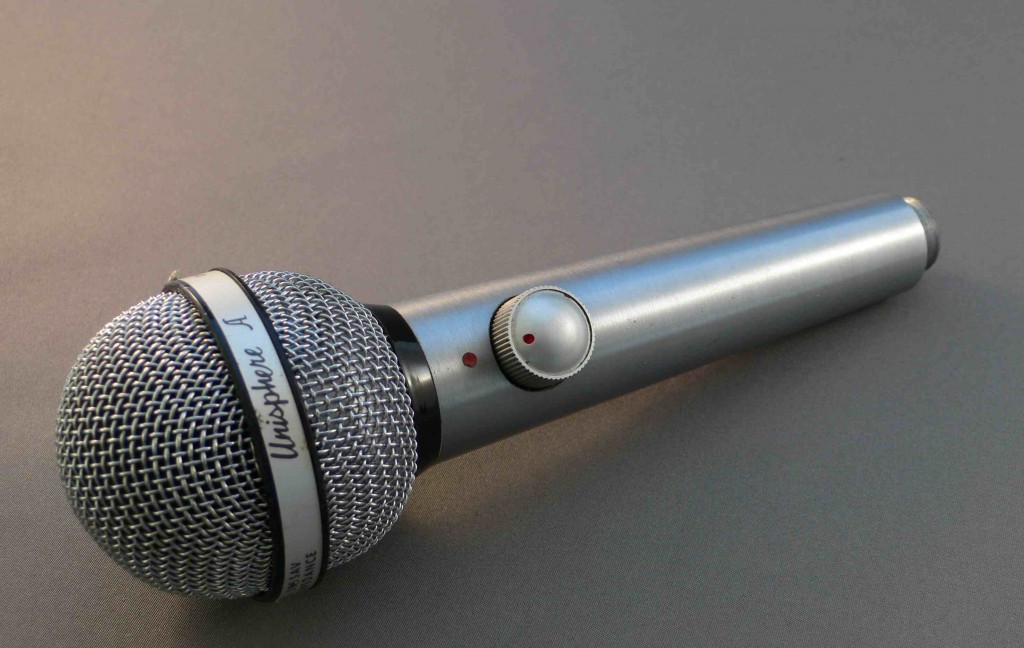 Shure 585 ‘unisphere A.’ Basically a cheap hi-z dynamic with a volume pot built in. I think this is known as the ‘James Cotton’ mic. Cotton was a harmonica player in the 60s whi apparently used just about every amp and mic in existence at one point or another, cos there is really no limit to the range of items people are eager to associate with him.
Shure 585 ‘unisphere A.’ Basically a cheap hi-z dynamic with a volume pot built in. I think this is known as the ‘James Cotton’ mic. Cotton was a harmonica player in the 60s whi apparently used just about every amp and mic in existence at one point or another, cos there is really no limit to the range of items people are eager to associate with him.
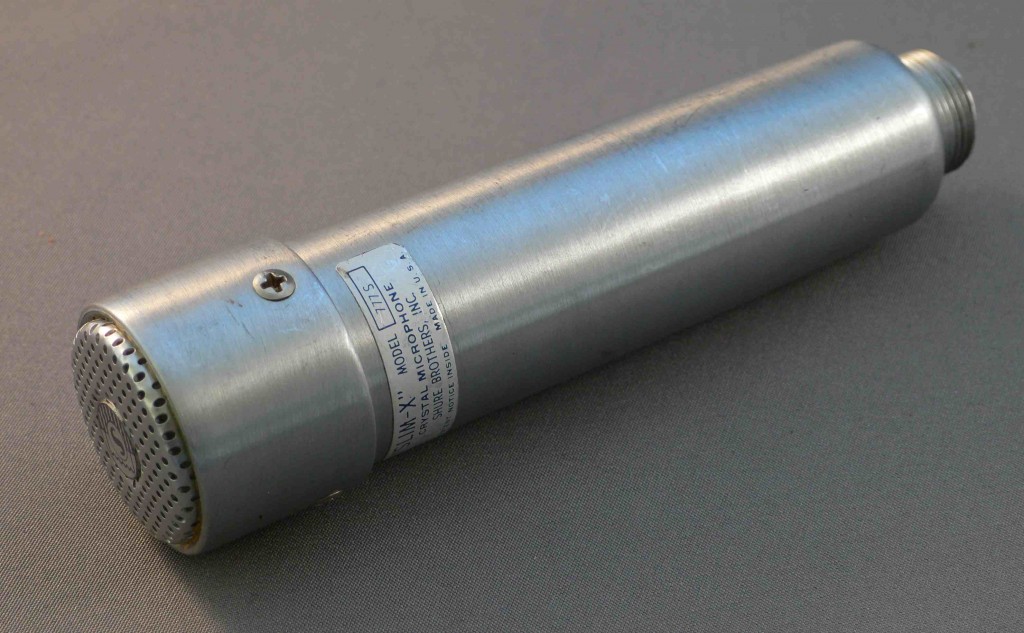 Shure 777s Crystal mic with switch. I think this came with a large pile of old mics. It’s a 60 year-old crystal mic. not much more to say.
Shure 777s Crystal mic with switch. I think this came with a large pile of old mics. It’s a 60 year-old crystal mic. not much more to say.
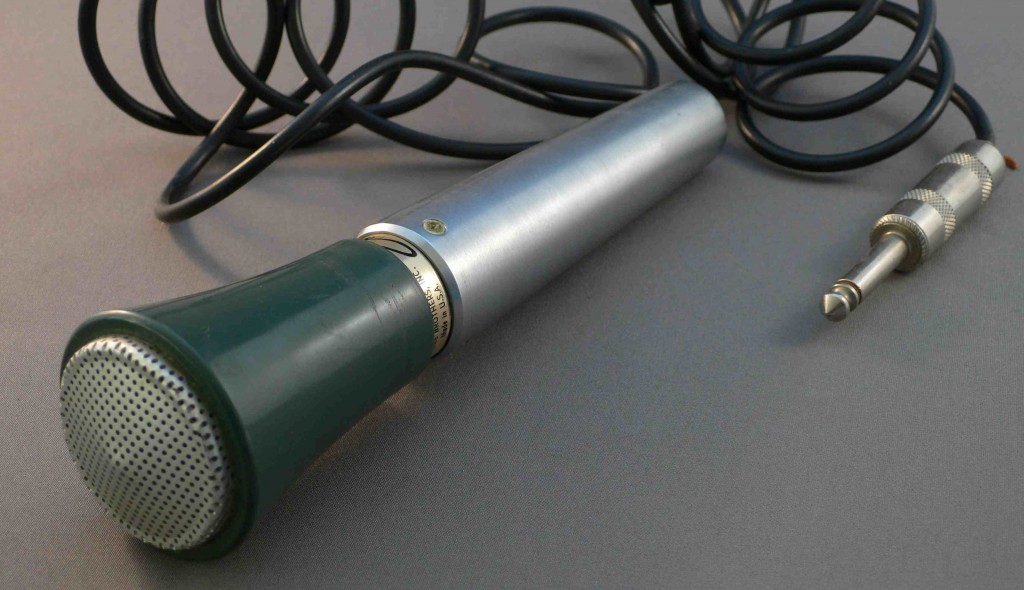 Shure Commando. Honestly not even sure what kind of mic this is. Sounds pretty cool but it’s hi-z so it’s a pain in the ass to use in the studio. harp (harmonica) dudes seem to dig these.
Shure Commando. Honestly not even sure what kind of mic this is. Sounds pretty cool but it’s hi-z so it’s a pain in the ass to use in the studio. harp (harmonica) dudes seem to dig these.
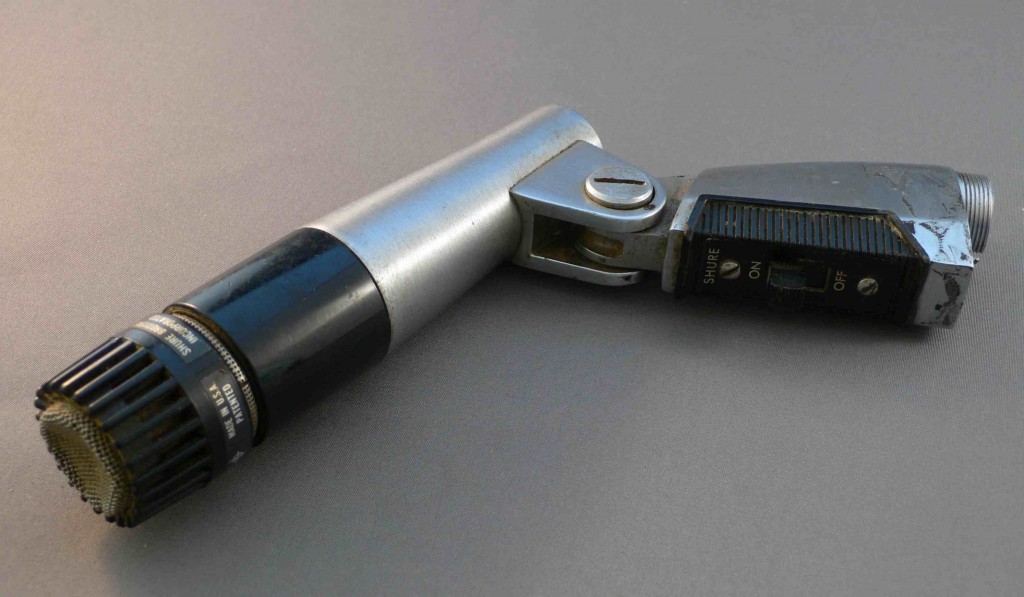 Shure PE-54. The ‘PE’ stands for ‘Professional Entertainer,’ believe-it-or-not (seriously, though, this is true.). This is the hi-z version of the Unidyne III… which is the forerunner of the SM57. This is actually a really good sounding mic, but since it’s hi-z, it’s a pain to use. I have an SM56, which is the balanced version of this thing, so this is kinda redundant. but for real this mic sounds great. i was surprised.
Shure PE-54. The ‘PE’ stands for ‘Professional Entertainer,’ believe-it-or-not (seriously, though, this is true.). This is the hi-z version of the Unidyne III… which is the forerunner of the SM57. This is actually a really good sounding mic, but since it’s hi-z, it’s a pain to use. I have an SM56, which is the balanced version of this thing, so this is kinda redundant. but for real this mic sounds great. i was surprised.
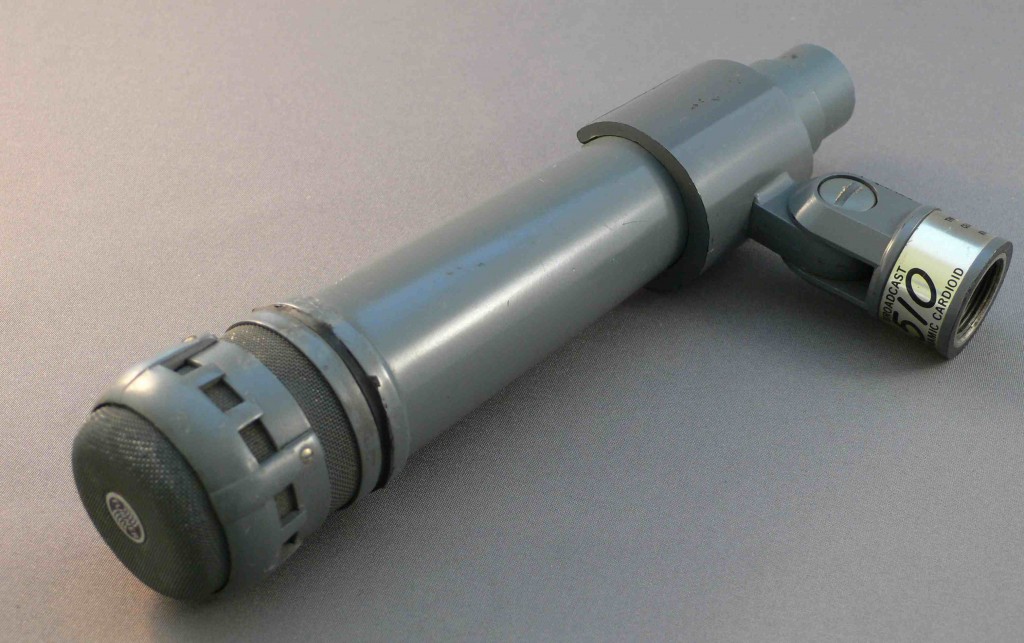 Turner 510. The best dynamic mic Turner ever made. I am actually not sure how this thing failed the SM57 test. Think maybe it deserves another chance. Look for a shoot-out including this mic. here. soon.
Turner 510. The best dynamic mic Turner ever made. I am actually not sure how this thing failed the SM57 test. Think maybe it deserves another chance. Look for a shoot-out including this mic. here. soon.
Download the entire twelve-page SHURE c. 1954 catalog:
DOWNLOAD: Shure_Microphones_1954_Catalog
Models covered include: Shure 333, 525, 300, 330, 55s, 556s, 51, 535, 530, 315; 430 Commando, 215, 715; A86A impedance-matching transformer; Slim-X, Monoplex, and Stratoliner; Green Bullet, Hercules, and Ranger; plus a wide range of tape heads and phono cartridges.
The Shure 55s and 556s (see images at left) are undeniably the most iconic of all microphones. Examples: when Elvis Presley got his postage stamp, he was pictured with a 55. When Eva Peron declared ‘don’t cry for me, Argentina,’ the Shure was there. (AFAIK).
For the curious: There are actually 4 different models of Shure Mic that get lumped into the ‘Elvis Mic’ designation. The 55s and and 556s seen on the left are the ‘small’ versions of the earlier 55 and 556. The ‘S’ means small.
As far as the difference between the 55(s) and the 556(s): the 55 is the ‘PA’ live-sound reinforcement version, and the 556 is the pro ‘broadcast’ version with improved frequency response and a built-in rubber isolation mount (hence the larger base), and presumably a better transformer.
*************
*******
***
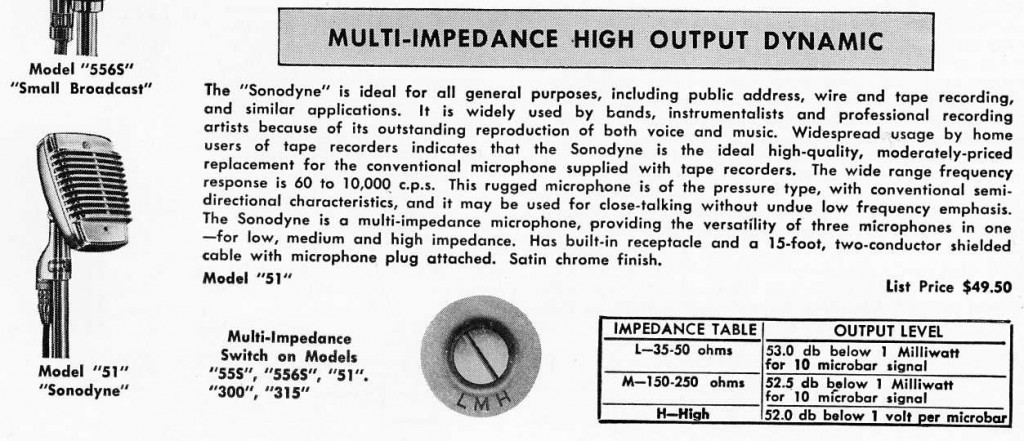 Besides these iconic 55-series mics, Shure made a great number of other models in the 50’s. The Model 51 seen above was one-step below the 55. These sound pretty cool. A few years ago I chanced upon a pair of 51s, still in sealed cartons. One worked, the other did now. One thing to remember with these early low-Z mics: they do not use XLR connectors. The use an earlier amphenol (i think..) screw-on connector. Easy enough to find, but keep it in mind if you plan on buying one, as you will likely want to replace the factory cable.
Besides these iconic 55-series mics, Shure made a great number of other models in the 50’s. The Model 51 seen above was one-step below the 55. These sound pretty cool. A few years ago I chanced upon a pair of 51s, still in sealed cartons. One worked, the other did now. One thing to remember with these early low-Z mics: they do not use XLR connectors. The use an earlier amphenol (i think..) screw-on connector. Easy enough to find, but keep it in mind if you plan on buying one, as you will likely want to replace the factory cable.
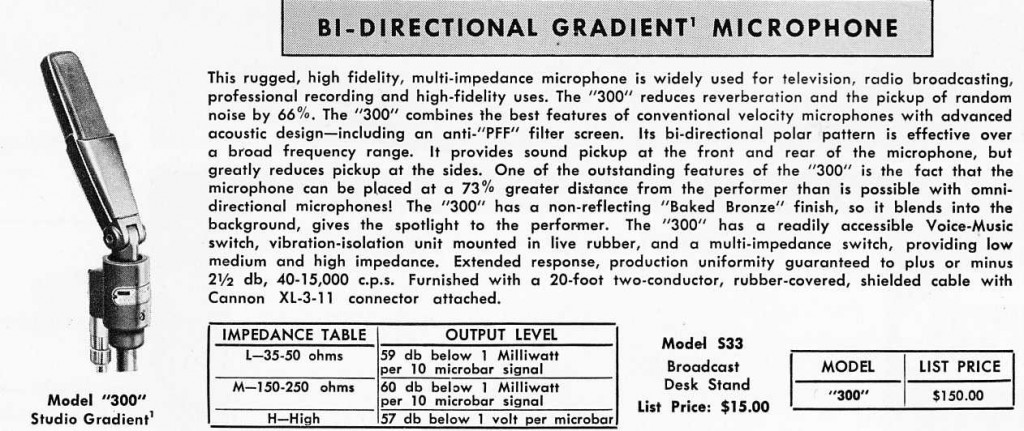 Shure also made 2 lines of ribbon mics into the early 1980s (they have only recently gotten back into this type of product). The 300 and 315 are the bi-directional figure-8 models (again, ‘broadcast’ and ‘PA’ models, respectively), and the 333/330 are cardioid ribbons. I have a mint-condition 300 which I had re-ribboned by ENAK repair. It sounds good but… the transformer seems to not be magnetically shielded, making it very sensitive to physical orientation. Combine this unfortunate feature with a very low output level and you get a mic that is frankly not very useful. Beware…
Shure also made 2 lines of ribbon mics into the early 1980s (they have only recently gotten back into this type of product). The 300 and 315 are the bi-directional figure-8 models (again, ‘broadcast’ and ‘PA’ models, respectively), and the 333/330 are cardioid ribbons. I have a mint-condition 300 which I had re-ribboned by ENAK repair. It sounds good but… the transformer seems to not be magnetically shielded, making it very sensitive to physical orientation. Combine this unfortunate feature with a very low output level and you get a mic that is frankly not very useful. Beware…
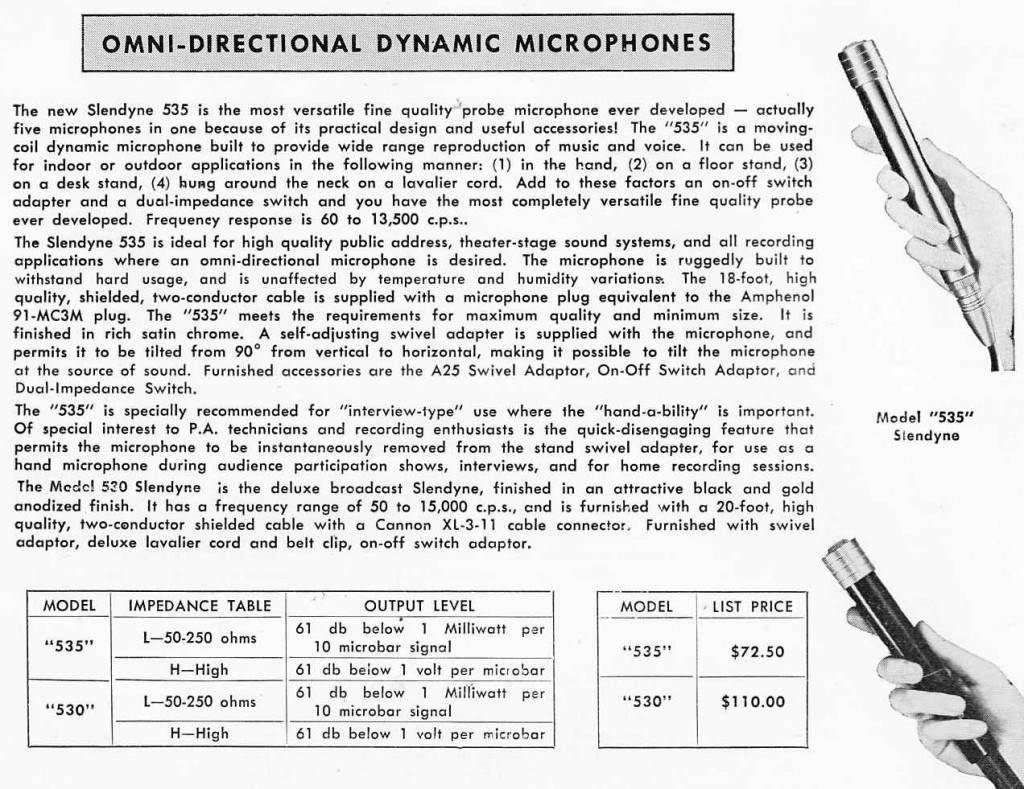 I also found pair of factory-sealed (hermetically-sealed foil-lined bags, actually) of military-surplus Shure 535s not long ago. The 535 has a limited frequency response, but it sounds pretty cool. These actually get used in the studio. A 535 was included in my ‘Forgotten Mic Shootout’ earlier this year, so follow the link to hear it if you are curious. I am honestly not sure why omnidirectional dynamics are no longer used much (Shure does still make a few models, btw), but they are useful for some recording tasks.
I also found pair of factory-sealed (hermetically-sealed foil-lined bags, actually) of military-surplus Shure 535s not long ago. The 535 has a limited frequency response, but it sounds pretty cool. These actually get used in the studio. A 535 was included in my ‘Forgotten Mic Shootout’ earlier this year, so follow the link to hear it if you are curious. I am honestly not sure why omnidirectional dynamics are no longer used much (Shure does still make a few models, btw), but they are useful for some recording tasks.
